
Building for the future at Brody School ECU
ECU HOMERS WITH LITTLE LEAGUE SOFTBALL


Building for the future at Brody School ECU
ECU HOMERS WITH LITTLE LEAGUE SOFTBALL
HOW ARTIFICIAL INTELLIGENCE IS CHANGING THE WAY PIRATES ARE LEARNING AND WORKING AT ECU


Brooke Rose, left, daughter of Petula Rose ’00, and the rest of the Pitt County Girls Softball League team powered their way to the 2024 Little League Softball World Series title. Read about it and how ECU played a key role starting on page 32.
AI has come to ECU’s campus, and nobody’s panicking. Instead, they’re putting it to work.
A new education building will position the Brody School of Medicine to train more physicians.
40
In search of a higher purpose, Joshua Williams traded trucking for engineering.


46 Football and Family
Third-generation Pirate Noah Holmes makes his mark on the gridiron.
East Carolina University is a constituent institution of The University of North Carolina System. It is a public doctoral/research-intensive university offering baccalaureate, master’s, specialist and doctoral degrees in the liberal arts, sciences and professional fields, including medicine. Dedicated to the achievement of excellence, responsible stewardship of the public trust and academic freedom, ECU values the contributions of a diverse community, supports shared governance and guarantees equality of opportunity. ©2024 by East Carolina University
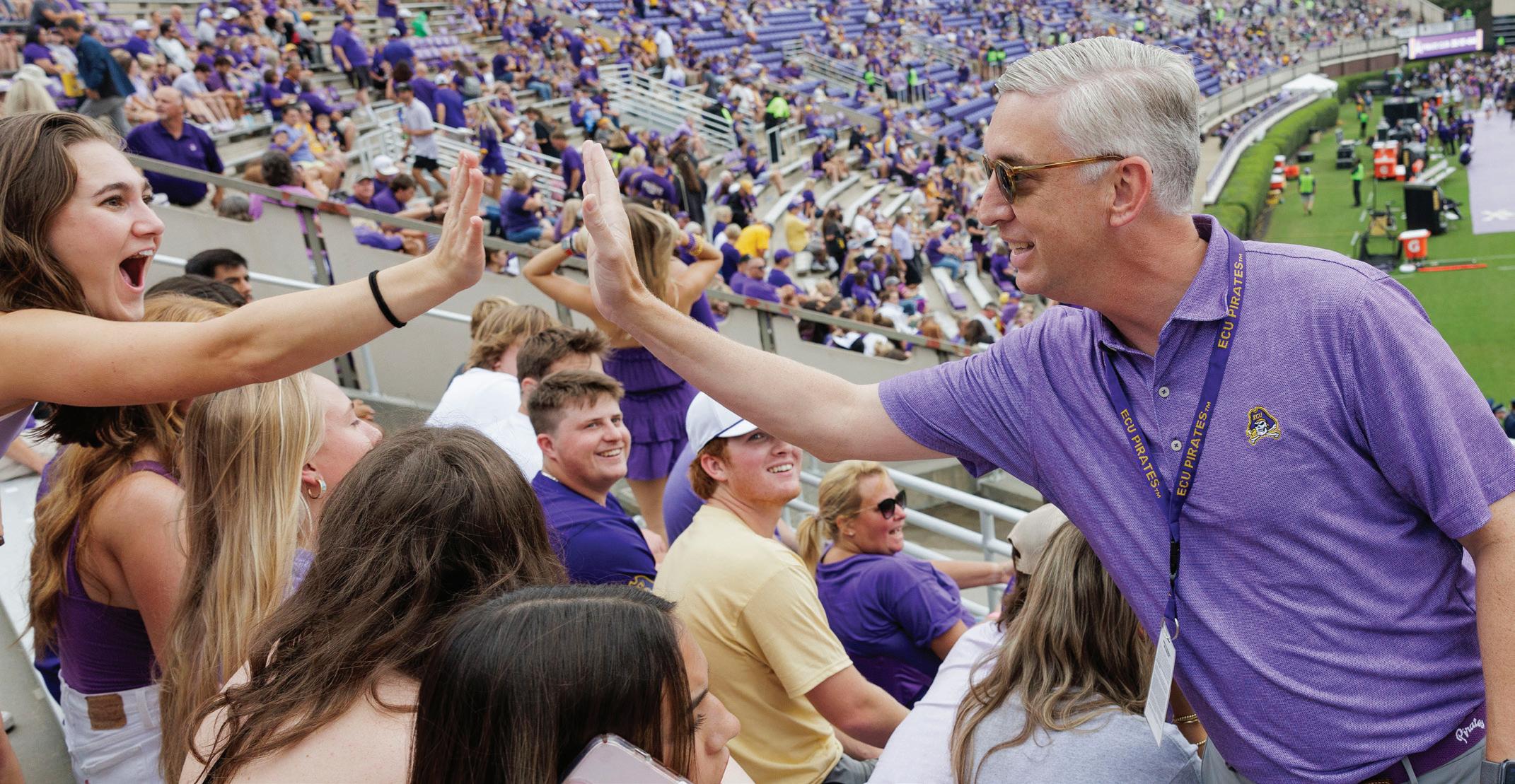
Thinking back to when we were in college, a lot of us remember – or think we remember – when student success depended pretty much solely on us: the students. Yet most of us also remember that professor who took an interest in us and our studies or the staff member who guided us to this class or suggested that major. If we can take those individual interactions, combine them with data and make them part of a more cohesive system, our students will be better off.
Why was it important to focus on student success during University Day in August?
We aspire to be a national model for student success, so University Day, right at the start of the academic year, was an ideal time to talk about it. Student success is a natural extension of our strategic plan – Future focused. Innovation driven. — we introduced at last year’s University Day. We’re accelerating steps to solidify and deliver on our student success agenda, so again, what better time to talk about it than the start of the year?
What are the student success priorities for this academic year, and why are they important?
We owe it to our students to be good stewards of their time and the resources they’re investing in earning their degrees. So here are five areas we’re focusing on:
• Use data to create clear retention goals for individual colleges and the university overall, and identify indicators to encourage timely degree completion.
• Build on our professional advising program, a foundational element to helping students graduate within four years.
• Start a benchmark campaign with a focus on growing the average number of credit hours earned by bachelor’s-seeking students in a given academic year.
• Make the university friendlier to transfer students and eliminate barriers to transferring credits.
• Align our fundraising goals and scholarship practices to create more scholarship offers earlier in the enrollment cycle.
What is the Chancellor’s Scholars initiative?
It’s an example of that fifth point. We’ve streamlined a couple of programs into the new Chancellor’s Scholars program that’s more robust and comprehensive, enabling us to do much more in this space. This effort will provide $2,500 recruitment scholarships that are renewable and will help students graduate on time with minimal debt and a meaningful credential leading to a prosperous and impactful career.
How does becoming a national model for student success fit into your OneECU philosophy?
We must be unified in our commitment to serve our students. Every division, department and academic college – every faculty and staff member on this campus — plays a key role in student success. That’s what OneECU is all about: collaboration, communication and a laser focus on helping our students reach their educational goals.
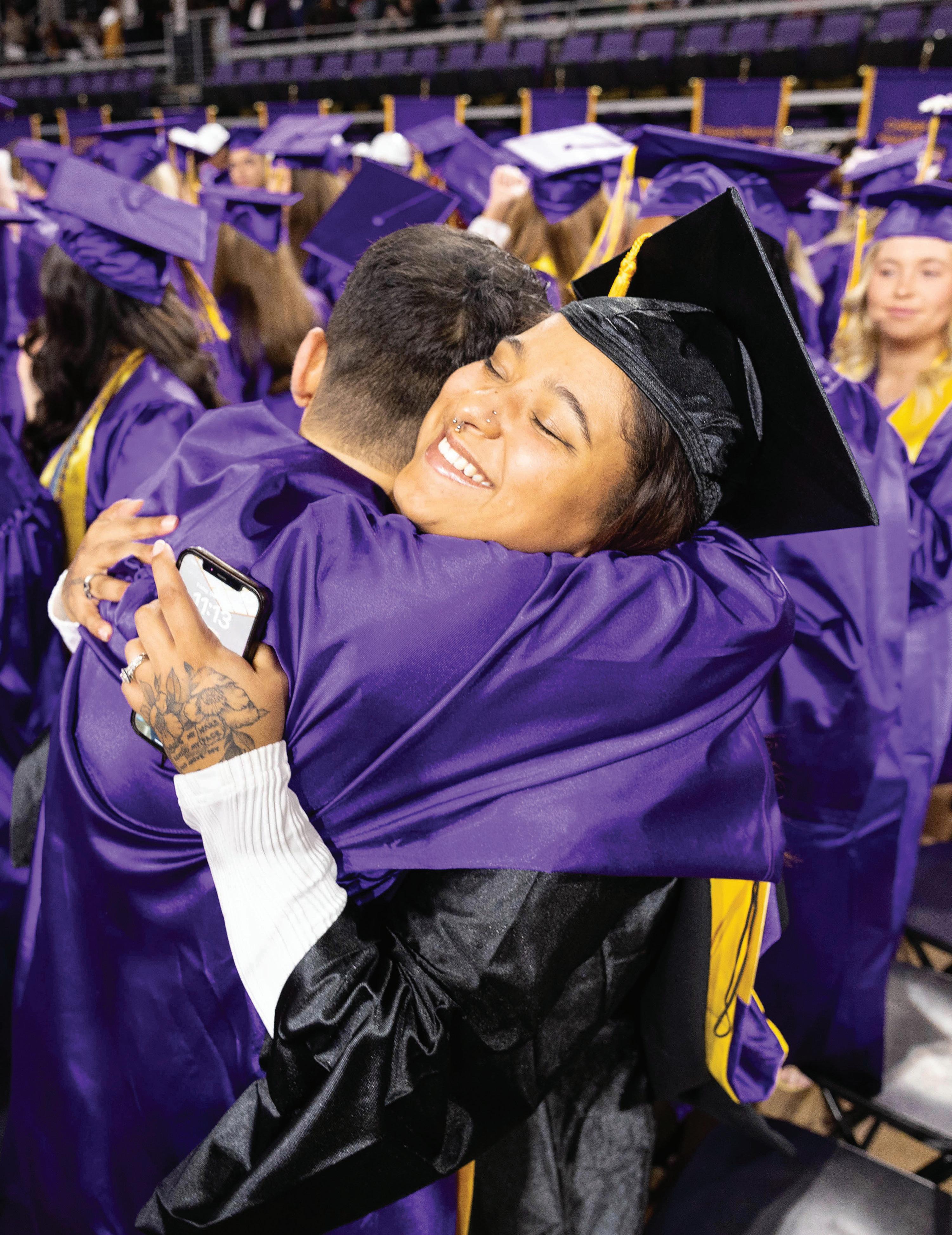
Tippett of Cooleemee, N.C., shares a hug with a fellow graduate at the conclusion of ECU’s 2024 fall commencement Dec. 13 in Minges Coliseum. Tippett received a master’s degree in school administration and was one of more than 1,900 who received bachelor’s, master’s and doctoral degrees at the event.
Heat stress mobile app to help outdoor workers ECU pitches in on Helene recovery
Recognizing ECU’s commitment to community engagement, innovation and economic prosperity, the Association of Public and Land-grant Universities honored the university with the 2024 C. Peter Magrath Community Engagement Scholarship Award and its Innovation and Economic Prosperity Award on Nov. 12 in Orlando, Florida.
ECU was one of four finalists for the Magrath Award after selection by the Engagement Scholarship Consortium as a regional winner in August of the W.K. Kellogg Foundation Community Engagement Scholarship Awards. ECU was selected for its efforts to address suicide and behavioral health needs facing rural North Carolina residents.
“ECU’s multifaceted approach to improving mental health in underserved communities in North Carolina illustrates the reach and vital importance of public universities to their states’ well-being,” said APLU President Mark Becker.
In 2006, ECU launched a partnership with Contentnea Health (formerly Greene County Health Care) to increase access to critical primary health care and behavioral health services for underserved populations. Suicide remains one of the leading causes of death among those ages 10-65 in North Carolina, with higher rates in rural areas and significant unmet mental health needs stemming from economic stressors, geographical isolation, family dynamics and health challenges. Through the years, the partnership has proven mutually beneficial for community members and university students and has provided 154 doctoral and master’s students with foundational clinical and research training.
“In my mind, there is no better initiative that personifies our mission and vision to be a national model for community engagement than ECU’s expansive partnership with Contentnea Health,” said Chancellor Philip Rogers as he accepted the award.

The partnership has supported more than 126,000 integrated behavioral health care encounters with patients through primary care and dental clinics, on farms and in school settings. The effort provides behavioral health services on average to 7,000 people each year.
“We built Contentnea Health on a foundation of service and commitment to the community,” said Contentnea Health CEO Melissa Torres. “The question we ask ourselves at the beginning of every collaborative opportunity is this: How does this opportunity benefit the health of our community? The answer to that question was clear in our partnership with East Carolina University. The community benefited.
We improved access to care by helping train therapists and by offering much-needed critical mental health care to our community. Together, we took one more step toward our vision of healthy people, healthy families and healthy communities.”
After learning the project he started with a handful of others 18 years ago had just won a national award, Dr. Tom Irons, a retired pediatrician, reflected on the dream that became a reality. Irons, a lifelong advocate for community health programs, served in multiple roles during his more than 40year career at the Brody School of Medicine at ECU.
“When we started on this, we were dreaming, looking for better ways to do what we do, which is caring for our marginalized neighbors or those who are otherwise disadvantaged,” Irons said. “We wanted to do something that would last and something that would give the community a voice that was equal to ours. And you know what? We did it.”
(A video about the project is at bit.ly/4hPV2BV. It mentions suicide.)
The second honor, the Innovation and Economic Prosperity Award in the Talent category, recognized ECU for using its student, faculty and staff expertise to assess, design and implement innovative strategies to address key needs across North Carolina.
Programs highlighted included the following:
• The North Carolina Statewide Telepsychiatry Program, developed in 2013 by ECU’s Center for Telepsychiatry and embedded in 29 hospitals and 27 community-based sites in 60 counties across the state. It has supported more than 60,000 emergency department assessments and more than 20,000 patients.
• The School of Dental Medicine Community ServiceLearning Centers, which bring dental expertise to rural communities and deliver services to some of the state’s most underserved areas. The eight centers help bridge the state’s dental provider gap while training future dental professionals to serve where most needed. Fourth-year dental students complete half-year rotations, providing care to patients and exposing them to multiple cultures and communities.
• The Early Educator Support Mentorship Program, a birth-to-kindergarten teacher-preparation project that incorporates rigorous training to better equip educators in supporting children. ECU serves as a regional hub for the statewide program, which is required of all early childhood lead teachers in nonpublic schools. It gives 800 pre-kindergarten teachers a pathway to earn or maintain their teaching license while promoting positive developmental outcomes for more than 8,000 children annually.
– Jeannine Manning Hutson and Kim Tilghman
Torre Blake ’16, daughter of former ECU quarterback Jeff Blake ’94, wowed judges and audiences on season 26 of NBC’s The Voice this fall, winning a spot on Team Snoop with her stirring rendition of Erykah Badu’s “On & On” and then advancing with a masterful performance of “What You Won’t Do for Love” by Bobby Caldwell. Her run ended in the knockout round Nov. 18. Follow her on Instagram @torreblake. Photo courtesy of WITN

In 2023, East Carolina University College of Business finance students Pierson Elwell and Gregory Sharafinski developed a proposal during a flight to San Francisco, aiming to improve experiential learning for future students.
Their idea was inspired by discussions with Sanford Bailey ’64, a COB alumnus who funded trips to financial hubs like New York City and San Francisco, emphasizing the importance of travel for networking and career opportunities.
“Pierson and I sat next to each other and hammered out an initial guide on how the gift could be used and how it could operate,” said Sharafinski. Connecting with other individuals would be a key goal.
“Travel is extremely important,” said Elwell. “Getting those connections established and getting students placed in high finance roles –those are some of the biggest outcomes we can expect from Blacksail.”
As a result of their efforts, the Blacksail Fund has been established with a $1 million donation from Bailey. This student-managed investment fund will allow COB students to gain hands-on experience in financial portfolio management, with proceeds supporting travel and other experiential learning activities. The fund will also provide access to a Bloomberg terminal, equipping students with vital real-time financial data and tools.
“I believe this (gift) will result in higher levels of achievement after leaving the college experience and broaden students’ contact bases, which is so important as they enter the competitive job market,” said Bailey.
COB Dean Mike Harris says the fund will position the college as a destination for students who want to enter the financial industry.
“We’re raising the bar regarding experiential learning and other experiences here in the college,” said Harris. “As we grow, our alumni
expect more. Their support makes the college more competitive and attractive to students.”
Matthew Slate ’96, a teaching instructor in finance and insurance, a veteran in financial markets and a member of the ECU Foundation board, will oversee the fund, aiming to mimic the real-world operations of an asset-management firm. He envisions the fund enabling students to develop critical skills and narratives that will boost their employability after graduation.
“What I hope comes out of it are practical experiences that make our students materially more attractive from a skill set perspective,” said Slate.
Christopher Dyba, vice chancellor for university advancement, said it’s not unusual for students to participate in fundraising and stewardship, but Elwell and Sharafinski elevated the role students can have in a noteworthy gift. “Pierson and Gregory went beyond participation and applied their entrepreneurial aptitude to an idea and turned their donor-funded experience from a pitch to a proposal, which will create new opportunities for students,” he said.
– Michael Rudd

The American Industrial Hygiene Association in July launched a heat stress mobile app — co-developed by ECU researchers — to help workers, employers and safety professionals address the increased risk of heat illnesses posed by rising temperatures.
The free app, available for Android and Apple mobile phones, was developed by heat safety experts from the AIHA Thermal Stress Working Group through a partnership with ECU.
Faculty members Jo Anne Balanay and Sinan Sousan, joined by ECU director of licensing and commercialization Carlyle Rogers, have worked with AIHA and software development company Dualboot Partners to develop it. The app is in its beta version as AIHA is collecting feedback from users.
The app allows users to enter information such as location and workload that factor into their overall heat stress risk assessment.
Combining this information with weather data from the local National Weather Service, the app
calculates an individual’s wet bulb globe temperature index, a recognized standard for evaluating potential heat stress. The app also provides heat alerts based on users’ work schedules and the heat stress risk level at their location, as well as recommended health interventions like rest breaks and water consumption.
“It’s giving the current WBGT, as well as the forecasted WBGT,” said Balanay. “Forecasting is one thing that is not done by the traditional heat stress monitor, which just gives what it is measuring right now. The purpose of the forecasted WBGT is it can be used for planning. Supervisors, for example, they can plan ahead in terms of rescheduling work according to workload and WBGT.”
Cloud cover is an included feature, giving app users the option to choose their outdoor sun exposure from sunny, mostly sunny, mostly cloudy, cloudy or full shade.
“I’m testing that option out to see how accurate it is compared to the heat stress monitors,” Balanay said. “I’ll come out and if it’s cloudy, I’ll adjust the WBGT app into the cloudy setting and note that in comparison to what the traditional instrument would measure.”
There’s no federal heat injury and illness prevention standard, but the Occupational Safety and Health Administration published a proposed standard Aug. 30. If adopted, it would require employers to develop and implement heat injury and illness prevention plans with input from and the involvement of nonmanagerial employees and their representatives. Employers with more than 10 employees would be required to have written plans, and all employers would need to designate one or more heat safety coordinators.

A handful of states have heat illness prevention program standards, and Minnesota has a standard for exposure to heat and cold.
– Ronnie Woodward
The AIHA heat stress app displays health recommendations in addition to heat stress risk level and heat index, humidity and wet bulb globe temperature data.
Photo by Jo Anne Balanay
ECU’s commitment to service and social mobility has earned it a top spot in a national ranking by Washington Monthly. Another organization, The Princeton Review, has included ECU in its 2025 edition of the Best 390 Colleges. Both were released in September.
According to Washington Monthly, ECU is in the top 10% of the 2024 Best Bang for the Buck schools in the Southeast, ranking 29th out of 277 institutions in that region.
Nationally, ECU ranks 70th among 438 universities, placing it in the top 16% based on social mobility, research and public service.
Washington Monthly also recognized ECU as one of the top three universities in North Carolina and one that excels in social mobility and service, ranking 63rd and 66th nationally, respectively. The Washington Monthly rankings evaluated 1,487 institutions, considering equal weight for social mobility, research and service.
Y2K is A-OK

Jan. 1, 2000, came and went without much of a hiccup from the infamous Y2K bug – a prediction that computers worldwide, programmed with two-digit date codes, would go haywire when the calendar rolled to the year ’00. The Brody School of Medicine had no problems after months of preparations and upgrades, said Gary Vanderpool, associate dean for business affairs. “Our people put in a great team effort,” he told the health system newsletter. Not everyone was convinced Y2K was a thing. “I think (the Y2K bug) is all propaganda,” junior Joe Poran told The East Carolinian

The Princeton Review highlights student feedback on various aspects of university life. ECU’s profile showcases positive student comments on its engineering and nursing programs as well as the extensive support services available, including a well-resourced library, tutoring centers and career support, emphasizing the university’s dedication to student success. ECU also is among the top 500 universities in the country named in the 2025 Best Colleges in a new Wall Street Journal College Pulse ranking. ECU is in the top half of 13 N.C. schools listed. ECU ranks 222nd overall, including No. 87 for social mobility.
–
Crystal Baity
The Student Government Association, followed by the ECU board of trustees, approve what’s known as “Operation Freebird” – a rule that would allow freshman women living in residence halls to come and go as they please, overturning years of curfews and restrictions; ECU was the last school in the UNC System to have such a rule. Wrote The Fountainhead editorial page as the change was being considered: “Why not give freshman women the chance to be treated like everyone else on this campus? If not, then at least lock up the freshman men – and see how long that lasts.” years ago years ago

A recent report by Meghan Millea and Vera Tabakova, faculty members in the ECU Department of Economics, revealed ECU had a total economic impact of $2.3 billion in eastern North Carolina and $2.5 billion across the state during fiscal year 2023. Here are highlights:

University operations, which includes salaries, scholarships and the expenses of supplies and utilities, accounted for $1.5 billion
Student spending on housing, dining and other purchases totaled $531 million


Research activity reached $85.6 million in grant funding. Costs associated with conducting research at ECU exceeded $125 million


Alumni entering the workforce in North Carolina contribute through their degrees and increased salaries. In-state alumni generated dividends exceeding $100 million for the state.
Capital projects spending totaled $18.9 million, which included buildings, machinery and equipment, general infrastructure, computer software, leased services and other expenditures.




Overall, ECU’s economic activities increased the region’s personal income by $963.2 million
– Kim Tilghman
years ago years ago
Met star visits ECTC

Metropolitan opera star Eleanor Steber performed Oct. 26, 1950, in Wright Auditorium, singing arias by Mozart and Verdi, “Summertime” by Gershwin and more before an audience of 1,800. The Teco Echo reporter Faye Batten met her that morning at the Hotel Proctor for an interview over a breakfast of coffee and grapefruit. Steber talked about her upbringing in West Virginia, her education at the New England Conservatory of Music, the fact she spoke four languages and liked to play golf and cook. As for college, she told Batten, “Yes, I, too, considered 8 o’clock classes the height of stupidity.”
The Y-Hut opens

Since 1922, the YWCA had operated a store in the basement of Austin where students could buy “clean, wholesome groceries, fruits, etc.,” according to Joyner Library archives. In 1925, after students had worked and saved, the Y got its own space: a low, red building in the woods near Eighth Street. The cabin was razed in 1952 to make way for Joyner Library. A second Y-Hut was built to take its place and in 1975 was renamed the Ledonia S. Wright Cultural Center.
Five ECU alumni received Outstanding Alumni Awards and a longtime Pirate friend was also honored by the ECU Alumni Association, recognizing their careers and service to the university. The awards were presented during homecoming weekend Oct. 25-27.

Dr. Linda Edwards ’81 serves as associate professor and dean of the University of Florida College of MedicineJacksonville. From advancing medical education to providing care as a practicing physician, Edwards has made many contributions to the medical field. She is known for her mentorship and outreach activities aimed at improving health care access.
Alice Keene ’73 ’81 is a lifelong champion of recreation opportunities in Pitt County and North Carolina and continues her work, post-retirement, as the recreation projects coordinator for Pitt County. Keene has been recognized for her efforts with numerous awards, including the Title IX 50th Anniversary Lifetime Achievement Award in 2022. Pitt County’s regional park on County Home Road is named in her honor.
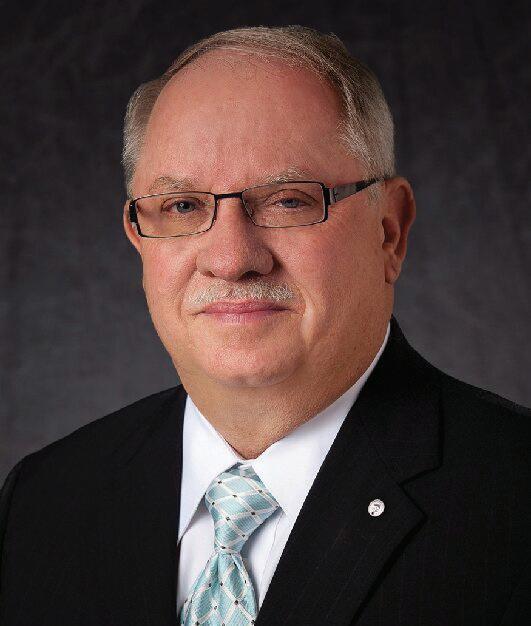


Harold Varner III ’12 is a professional golfer in the LIV Golf League. He was the first player in ECU men’s golf history to be named Conference USA Golfer of the Year and was inducted into the ECU Athletics Hall of Fame in 2022. Harold and his wife, Amanda ’12, made a transformational gift to the Pirates Unite Campaign for Comprehensive Excellence, supporting the golf program and the Isley Indoor Performance Center.
Caitlin Cummins ’14 received this year’s Young Alumni Achievement Award. Cummins is owner and CEO of Terra Bella Compost LLC, a business she created from a campus composting project. Terra Bella Compost offers commercial and residential food waste hauling and processing. Cummins has volunteered with the N.C. State Extension Children’s Gardening Program, the Pitt County Farm and Food Council and the Catholic Charities food drive.

Danny Rice ’73 has dedicated his career to serving individuals with disabilities. For more than two decades, he served as director of community services at Caswell Developmental Center in Kinston and was the founding executive director of the center. Rice and his staff provided services to people with disabilities and their families across 32 counties.

Lance Clark received an Honorary Alumni Award for his generosity and commitment to ECU. He is co-owner and president of Bill Clark Homes and has partnered with the city of Greenville to provide quality affordable homes for homeowners. His dedication to ECU is evident through fiscal stewardship to the university, student mentorship and job opportunities upon graduation for students.
– Patricia Earnhardt Tyndall
Four ECU alumni were honored for their service to the country during the Distinguished Military Service Society ceremony in November. They join 79 others who have been inducted since 2008.

U.S. Rep. Don Davis ’01 ’07 is an Air Force Academy graduate and served as an officer in the Air Force for eight years. He coordinated Air Force One and congressional delegation operations at Andrews Air Force Base and supported families of military members as a mortuary officer.
Following active duty, Davis worked as an assistant professor of aerospace studies at ECU Air Force ROTC Detachment 600. Among his honors are the National Defense Service Medal and the Southeast Region United States Air Force Instructor of the Year.
He also served as mayor of Snow Hill, served six terms in the N.C. Senate and was elected in 2022 to the U.S. House of Representatives.
Retired Air Force Col. George R. Farfour ’89 is the associate dean of the School of Strategic Force Studies at the Air Force Institute of Technology. He served as an intercontinental ballistic missile officer for most of his career, with experience in nuclear war planning, national nuclear policy and arms control policy.

Farfour was commissioned as a distinguished graduate of ECU’s AFROTC. He established an alumni group for Detachment 600 and administers an annual scholarship.
His 37 years of active duty resulted in numerous honors including the Defense Superior Service Medal and the Nuclear Deterrence Operations Service Medal with “N” device and four oak leaf clusters.

Navy Lt. Cmdr. Eric Green ’13 enlisted in the Navy as a hospital corpsman and was later commissioned as a Navy medical service corps officer.
Green has served during Operations Enduring Freedom, Iraqi Freedom, Iraqi Freedom III and Inherent Resolve.
His commendations include two Meritorious Service Medals and Naval Medical Center Camp Lejeune Officer of the Year.
Green has led global health engagements, strategic medical planning activities and mitigated environmental health threats around the globe. He also established a memorandum of agreement between ECU and Camp Lejeune to provide ECU students with military medicine experience.
Retired Army Col. Rodney A. Mallette ’88 is the special advisor to the chairman of the board for International Auto Logistics.

He was commissioned as a distinguished military graduate from the University of Alabama and has an MBA from ECU. He served more than 27 years in the Army, including a post as chief of staff, Military Surface Deployment and Distribution Command.
He is a three-time recipient of the Legion of Merit and received a Defense Meritorious Service Medal and a Joint Service Commendation Medal.
He serves on ECU’s Honors College Advancement Council, and he and his wife, Wanda ’75, established a scholarship in the College of Business to support veterans or their spouses.
– Patricia Earnhardt Tyndall
In the aftermath of Hurricane Helene, ECU showed its commitment to community, echoing the aid it received during Hurricane Floyd 25 years earlier.
As UNC Asheville faced significant challenges, ECU Dining dispatched two food trucks to provide meals for students shortly after the hurricane struck. One of those students was Will Fairley, whose mother, Candice MatelskiBrady ’02, was also a sophomore at ECU during Hurricane Floyd.
“The day before Helene struck, I told my sister the amount of pre-rainfall reminded me of the days before Floyd,” said Matelski-Brady. “Will told me that ECU Dining came to Asheville to help feed students. I smiled and said, ‘ECU remembers. Now they are paying it forward 25 years later.’”
In addition to providing food assistance, ECU sent four police officers to Asheville to help local law enforcement manage the increased demands on their resources.
Meanwhile, ECU students and alumni took to the skies, delivering essential supplies to remote areas affected by the storm. Notable among them was Dr. Jonathan Austin ’16, a dental alumnus who flew his Piper Arrow to transport aid to hard-hit communities. (Read more about Austin’s work at bit.ly/3YF5tAO.)
“We’re not afraid to get our hands dirty,” he said. “Several of us in our class knew we would return to our hometowns to practice dentistry and help our communities. With this, I just tried to do what needed to be done.”
Leading the N.C. National Guard’s efforts was Maj. Gen Todd Hunt ‘88, adjutant general of the guard. More than 500 NCNG soldiers deployed to the region and, together with other military personnel, rescued 765 people and delivered supplies and assistance to many more.
Among those NCNG soldiers was ECU senior Cameron Smitherman, who played a direct role
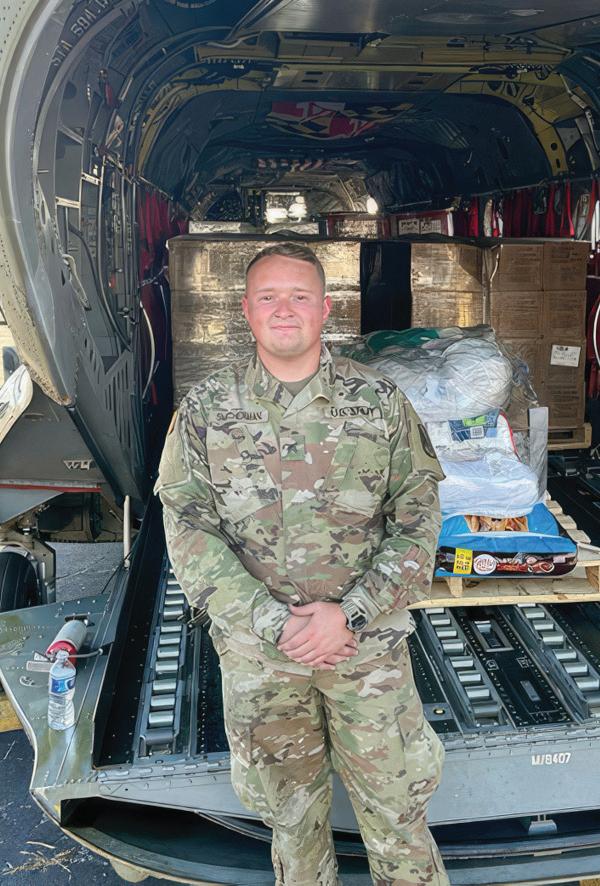
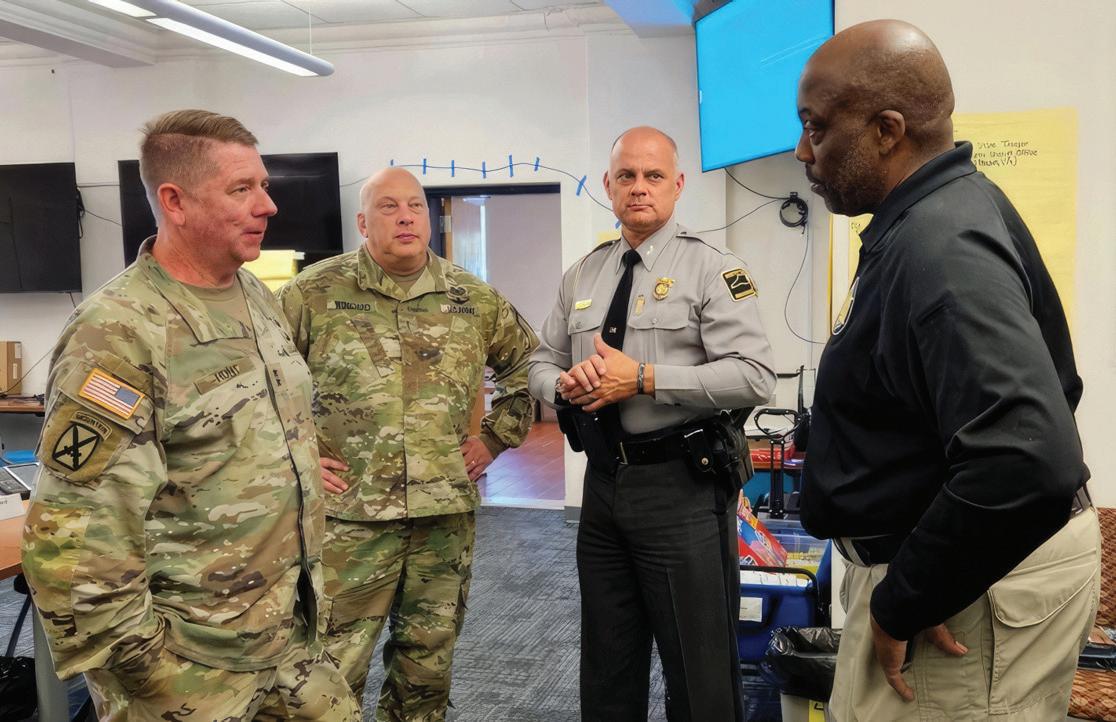
in recovery efforts, helping to deliver food and generators to those cut off from essential services.
“Often, we were the first contact these people have had since the storm,” he said.
Community support flowed through local churches, businesses and organizations, notably at Ignite Church in Greenville, which served as a donation hub. Richard Allsbrook ’91 ’02, an ECU criminal justice instructor, delivered the goods to the western part of the state.
“It’s anything but normal in the mountains,” Allsbrook said. “Sometimes it’s hard to measure help, but any way that anyone can help is help, because I am 100% certain it is needed.”
Student-athletes set rivalries aside and joined the effort, with ECU football players volunteering at Ignite and Appalachian State basketball players and track-and-field athletes meeting Allsbrook to help unload the truck.


Bryan Butterworth, Preston Carr and other players help prepare donations at Ignite Church in Greenville for delivery to Black Mountain, N.C. Right, CW2 Karen Shoaf ’14 watches as hay is loaded onto her U.S. Army CH-47F Chinook helicopter in western North Carolina. Shoaf, a pilot stationed at Fort Liberty, was among the approximately 1,000 active-duty troops from the 82nd and 101st airborne divisions deployed to western North Carolina.
“I’m a Pirate, but now an App State basketball fan, too,” Allsbrook said.
The School of Dental Medicine’s servicelearning centers in Spruce Pine and Sylva faced challenges as well. All faculty and staff are safe, and operations at Sylva have resumed. The town of Spruce Pine, however, sustained heavy damage including the destruction of its water treatment facility, so the dental center there is open only for emergency cases.
Bryan Edge ’97, a video content producer in University Communications, spent Oct. 5 in Newland as a volunteer with Samaritan’s Purse.
“We were assigned to help a woman named Sue in her late 70s who lived in a small neighborhood,” said Edge. “Her husband died of natural causes on the same day the storm hit, and she lost her mother and dog earlier this year. The entire first floor of her house was submerged by
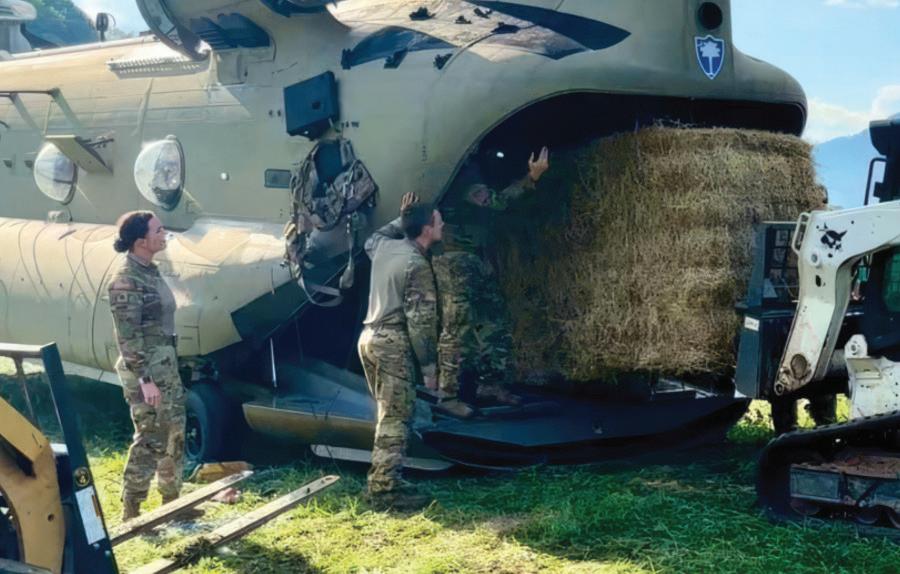
floodwater, and while the water had receded by the time we arrived, substantial damage was already done.”
Edge went to work removing the air duct insulation while wearing necessary protective equipment due to mold. Later, a second job revealed a bit of light in a shed where Sue designed stained glass windows.
“She used this shed as her studio,” said Edge. “Sue was concerned that her works were damaged, but miraculously her work was only covered in mud and could easily be rinsed off.”
Ivy Bagley, a four-time ECU graduate, provided medical assistance to displaced individuals, particularly elderly ones.
“Some patients were from nursing homes, and others were there due to needing electricity for home medical equipment,” she said. “Many need us to listen and be supportive.”
Bagley has a Healthcare Emergency and Disaster Management certificate from the College of Nursing and has a National Healthcare Disaster Certification. She encouraged people to not forget the mountains after the headlines go away.
“In a few months, still remember those who lost all, and as towns rebuild or artisans begin to work again, support their local businesses,” she said.
– ECU News Services
ECU investigations, research and creative activity benefiting the region and beyond

Eastern black rails are rare. Susan McRae, a teaching professor in the ECU Department of Biology, estimates their numbers are in the hundreds.
So the times she’s seen one in the wild stand out. Two of them were in North Carolina.
“Both times, I was training my graduate student, Bailey Kephart,” McRae said. “The first was in the early days of her fieldwork. We were looking for a good location to put a trail camera, and we happened to flush one at close quarters. It flew up and over some black needlerush then swiftly disappeared into it.
“The second time was a couple of months later. We were traversing a vast area of marsh on foot, and we flushed another out of the reeds. It flew about 50 meters just above the vegetation then dropped down again into it. Each time we stopped in our tracks to savor the moment. It is such a thrill.”
McRae recently received the Animal Welfare Institute’s prestigious Christine Stevens Wildlife Award. The award provides grants of up to $15,000 and is named in honor of AWI’s late founder and longtime president who dedicated her life to reducing animal suffering.
McRae’s interest in the rail family started in 1991. In 2020, the U.S. Fish and Wildlife Service declared black rails (Laterallus jamaicensis jamaicensis) a threatened species under the Endangered Species Act.
“I wasn’t even sure if there were any left,” she said. “They are so rare, and I didn’t necessarily see it as a viable student research option because I wasn’t sure if they would find them.”
However, in 2017 she received a research grant and recruited a graduate student. The student developed an eDNA diagnostic technique for detecting black rails and did find a few.
Nicknamed “the feathered mouse,” black rails are small, shy, nocturnal birds — weighing just
more than an ounce — with short legs. They like moist soil and have been located in tidal areas of Carteret County.
The goal is to understand more about black rails’ ecology and behavior to assist in their conservation. Humans moving into coastal areas, sea-level rise and fires are a few aspects that disrupt and hinder the birds’ natural environments.
Through this new grant, McRae will work with Robert Driver ’22, a postdoctoral research scholar at Duke University in the Department of Molecular Genetics and Microbiology, who tests substances that bind to olfactory receptors. He is identifying scents for McRae to use in the field, which may attract and lure the black rail.
The research is risky because neither knows if the scents will attract the birds. However, if they can identify smells the birds like, trail cameras may capture their movements without human interference.
“I know that we are going to get interesting information from the camera deployments, one way or another, but it will be a fun challenge to try some new things,” McRae said.
– Lacey Gray

An ECU team has received a grant of nearly $900,000 from the federal Substance Abuse and Mental Health Services Administration to tackle health disparities and improve substance use disorder outcomes in eastern North Carolina.
This funding aims to improve the training of health sciences students and provide educational opportunities for local providers through the ECU-AMMPeD program, which stands for Amplifying Medical, Midwifery, Nurse Practitioner and Dental Education. Led by Chandra Speight and Sarah Noe from the College of Nursing, the initiative seeks to increase access to substance use disorder treatment in a region plagued by high overdose rates and limited provider capacity.
The grant will facilitate clinical placements and create virtual clinical experiences for students from various health disciplines. The urgency of this initiative is underscored by alarming statistics: In Pamlico County, for example, overdose deaths reach 102 per 100,000 residents, versus the national rate of 32.6 and a state rate of 41.4 per 100,000, according to the N.C. Department of Health and Human Services and the federal Centers for Disease Control and Prevention.
In addition, a separate grant from the Aetna/CVS Foundation, spearheaded by Dr. David Ryan of the Brody School of Medicine, aims to establish North Carolina’s first network of perinatal substance use disorder clinics, addressing maternal health amid rising addiction rates. Ryan, who specializes in obstetrics and addiction medicine, highlighted the need for effective care for new mothers, who often face barriers to accessing help.
“Mothers go through a pretty traumatic and dramatic experience with childbirth. It’s pretty standard in American health care that after two days we send them home and say, ‘See you in six weeks,’” Ryan said. “Then we talk to them for 15 minutes and say, ‘We’ll see you in a year.’”
Nearly half of the state’s children in foster care are affected by parental substance use, and nearly 40% of maternal deaths are substance-related, he said.
“Not hemorrhage or infection or cardiomyopathy. The study also included homicides and suicide which is 6.5%, which is also shocking,” Ryan said, though he sees glimmers of hope that come from the grants’ investment in vulnerable populations.
The ECU-AMMPeD program includes simulation training to prepare students for working with stigmatized populations.
The collaboration among dental, medical and nursing students will enable a comprehensive approach to substance use disorder treatment, as emphasized by Dr. Mark Moss from the School of Dental Medicine. He noted the necessity of integrating dental care into the broader health care system to combat addiction.
“This training builds the understanding and skills for ways to ask questions and talk about sensitive topics with our patients, as well as knowledge concerning the resources for community engagement and connection with other health professionals who can help us manage these situations,” Moss said.

“Our students are hungry; they want to know how they can be part of the solution,” Ryan said.
“If I can educate 100 students, and maybe half of them go on to understand addiction, now we’re influencing thousands upon thousands of people.”
– Benjamin Abel

Michael Shoaf
School of Theatre and Dance Associate professor
Michael Shoaf’s passion isn’t confined to teaching students or creating light and sound elements for productions in East Carolina University’s School of Theatre and Dance.
He shares it with the community, producing an annual holiday light show at his home on Harell Street in Greenville with more than 125,000 lights choreographed to seasonal songs. He started the display while in high school in Durham, where he grew up. He brought what is now a larger show to Greenville after he began teaching at ECU, in the same program where he earned his bachelor’s degree in 2013. He received an MFA from the University of Illinois Urbana-Champaign.
Shoaf began preparing the show this summer, virtually building it on his computer before putting up lights in October. The show has been featured in several news broadcasts, newspapers and even ABC’s The Great Christmas Light Fight. Like a theater production, Shoaf said he enjoys the reaction from viewers, who sometimes leave notes in his mailbox.
“The kids go crazy. They always want ‘Let It Go.’ Most of the adults love ‘Dominick the Donkey,’” Shoaf said.
He also is often asked for advice on lighting and sound design in area schools, where he has taught classes or helped price equipment for administrators.
In high school, Shoaf wasn’t sure what he wanted to study in college. He took a theater class, where he learned the offstage work required for productions.
“You realize there’s this background world of theater, and you can kind of control the audiences’ emotions with sounds, light,” he said. “Being able to teach students how to do that is a fun thing to dive into.”
It’s not uncommon for lighting designers at universities to do other things like sound or projection, which he enjoys. “I’m a very tech-heavy person and love the technology aspect of the job. Lighting tech, sound tech are important because if those go wrong, the show’s a bust,” he said.
Shoaf isn’t the only Pirate in his close-knit family. His sister Karen ’14 received her bachelor’s in exercise science and is an Army Chinook helicopter pilot. Sister Hannah started her medical residency at ECU Health this summer.
– Crystal Baity

Michael Harris has been named dean of the ECU College of Business. He had served as interim dean since July 2022. He started at ECU in 2004 as an assistant professor in the Department of Management. He chaired that department from 2014 until 2017, when he was named director of the Miller School of Entrepreneurship, North Carolina’s first named school of entrepreneurship. Harris has bachelor’s and master’s degrees in business administration from ECU and a doctorate from N.C. State University.
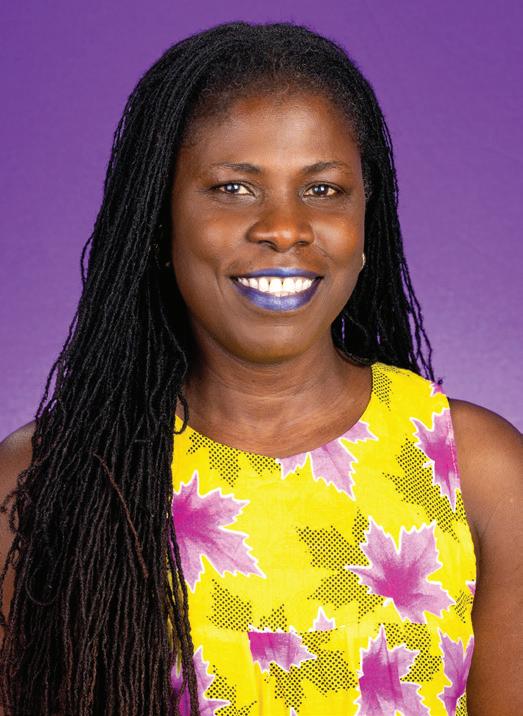


Marame Gueye, an associate professor in the Thomas Harriot College of Arts and Sciences Department of English, has won a competitive Fulbright U.S. Scholar Program award for the 20242025 academic year. Since Oct. 1, she has been teaching and conducting research on a 10-monthlong project titled “Discourses of Wifing.” It focuses on how Senegalese women think about wifehood as a service they render to men. Gueye focuses on African and African diaspora literature. She has bachelor’s and master’s degrees from Cheikh Anta Diop University in Senegal and a doctorate from Binghamton University, State University of New York.
Rukiyah Van Dross-Anderson, associate professor of pharmacology and toxicology at the Brody School of Medicine, won the second statewide NC Biotech Venture Challenge on June 27. She received $40,000 from the North Carolina Biotechnology Center in seed funding for her company, Claradele Pharmaceuticals, which is working on a patented therapeutic to treat melanoma. Van Dross-Anderson was one of five teams from across the state pitching their innovations. Claradele is in the preclinical phase of the commercialization process, which takes an invention and moves it through various checkpoints before it’s delivered to the market for public use.
Michael Waldrum, dean of the Brody School of Medicine and chief executive officer of ECU Health, has been named chair-elect of the board of the Association of American Medical Colleges. His term began Nov. 12, 2024, and lasts until the AAMC annual meeting in November 2025, after which he will serve a oneyear term as board chair. Waldrum served as chair of the AAMC’s Council of Teaching Hospitals and Health Systems (now called the Council of Academic Health System Executives) from 2022-2024.


STORY BY PATRICIA EARNHARDT TYNDALL

Fittingly on National Rural Health Day, Nov. 21, a crowd gathered on the East Carolina University Health Sciences Campus to ceremonially break ground on the new Center for Medical Education Building.
Speakers paused as EastCare helicopters buzzed overhead, returning to campus following patient transports. Two excavators suspended a large American flag over a mound of sand dignitaries and others would soon dig their shovels into. The venerable Brody Medical Sciences Building towered nearby.

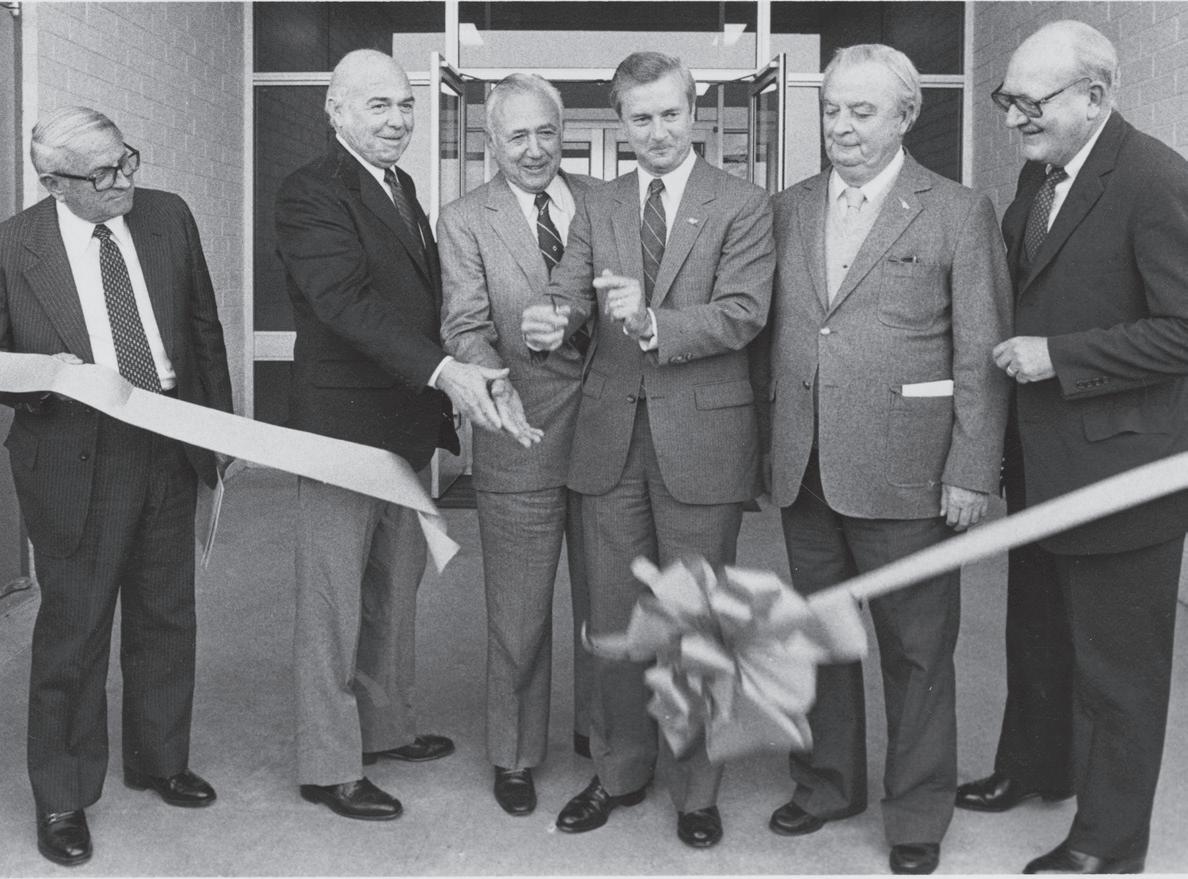
“We have a great culture, and we have a really strong and important mission. Having a facility and support infrastructure that promotes that is really important.”
Dr. Michael Waldrum, Dean of the Brody School of Medicine CEO of ECU Health
“There is a shortage of primary care doctors in our country that’s acute for rural Americans,” said Chancellor Philip Rogers. “We thank our state’s elected leaders and the people of North Carolina for their trust in our commitment to improve rural health and well-being. We pledge to steward this public investment in service of our medical students — the next generation of highly trained physicians giving patients throughout our state lifesaving help and hope.”
The N.C. General Assembly approved a total of $265 million for planning and constructing the seven-story, 195,000-square-foot building, which will be connected to the existing Brody Medical Sciences Building at every level. Faculty, alumni and supporters describe the building as an expansion that is long overdue.
“The facility is 100% designed with the students in mind,” said Dr. Jason Higginson, Brody’s executive dean. “Medical school is so rigorous. Success depends both on labs and hands-on learning environments along with quiet and comfortable spaces that host hours and hours of quiet study. Our students need all of it before they begin treating patients in clinical settings. They have it here at the Brody School of Medicine.”
“I think the investment in the new building shows the legislature’s acknowledgement of the school’s success in fulfilling the mission. It shows the value of the school not just to the region, but to the whole state.”
The facility will also accommodate larger class sizes than the Brody Building; school leaders expect classes to increase to 120 students once the expansion is complete.
Dr. Michael Waldrum, dean of the medical school and CEO of ECU Health, said having a modern, contemporary facility is important when trying to attract top-tier faculty and students.
“I think that people want to be here. We have a great culture, and we have a really strong and important mission,” Waldrum said. “Having a facility and support infrastructure that promotes that is really important.”
Since the 1960s, the Brody family has supported health sciences education and research at ECU. Family patriarchs Morris, J.S. “Sammy” and Leo Brody supported Chancellor Leo Jenkins’ drive to build a medical school at ECU, and in 1973 the family donated to the construction of what would become the Brody Medical Sciences Building.
“We are proud of the incredible progress made so far with limited resources. This investment by the legislature to ECU Health and the Brody School of Medicine will only continue the wonderful mission for many years and beyond,” said Hyman J. Brody II. “This investment is a continued testament to what vision, community commitment and innovation can accomplish.”


from left,
Gov. Jim
Chancellor Emeritus Leo Jenkins and Chancellor Thomas Brewer break ground March 30, 1979, for what would become the Brody Medical Sciences Building.
Above, among those participating in the Nov. 21, groundbreaking for the new medical building were, from left, Jason Poole, chair of the ECU board of trustees; Anderson Ward, student body president; former trustee Kel Normann; trustee Fielding Miller; N.C. Rep. Ray Pickett; UNC System President Peter Hans; ECU Chancellor Philip Rogers; Mike Waldrum, dean of the Brody School of Medicine and CEO of ECU Health; former N.C. Rep. Brian Farkas; N.C. Rep. Chris Humphrey; U.S. Rep. Don Davis; N.C. Sen. Buck Newton; ECU trustee Vince Smith; and Cassie Burt, vice chair of the board of trustees.

Here
• Two learning studios that can seat up to 500 people in a lecture/banquet style setting or transform into classrooms, meeting or seminar spaces seating up to 136 in each studio
• Flexible spaces including huddle rooms, pod-like collaboration spaces and small-group student spaces
• A roof terrace and green space
• A new home for simulation and standardized patient programs
• Four student houses – common spaces that will serve as a “home” for students to study, including lockers, changing areas and study carrels, serving blended groups of first-year to fourthyear students
• New gross anatomy space to include 28 beds
• Large instructional lab classroom for neurology, pathology and immunology with seating up to 144
• Lawn space for special events and ceremonies
• A 500-car parking garage to be constructed on the Health Sciences Campus
He and his cousin David Brody have witnessed the growth of the school and the growth of demand in eastern North Carolina for doctors, physician assistants, nurses and other health care workers.
“I think the investment in the new building shows the legislature’s acknowledgement of the school’s success in fulfilling the mission,” he said. “It shows the value of the school not just to the region, but to the whole state.”
Construction is expected to start in March, and when it opens in 2027, the Center for Medical Education Building will feature modern classrooms, anatomy labs and simulation technology integrated with flexible spaces, collaboration rooms, small-group student spaces and green infrastructure. Sections of the building will be designed as houses for four blended cohorts of Brody students. Common spaces will serve as a home for students to study, gather and recharge.
Higginson said the simulation and standardized patient spaces will be one of the many benefits to students.
“Those are learning studios where they’re going to learn the physical hands-on skills of being a physician. I think that is just going to be a huge upgrade,” Higginson said. “That’s the real heart and soul of being a doctor. How do you interact with a patient? How do you convey empathy? We’re going to be able to teach them that in state-of-the-art spaces. Those are really important formative events for students, and I think the building is designed to do that at the top level.”
The Brody Building will continue to house faculty offices, research labs and services critical to the mission of educating physicians. Higginson and Waldrum say the goal is to improve current spaces over time.
From classrooms and labs at Ragsdale Hall on ECU’s Main Campus to the Brody Medical Sciences Building — and many mobile office units that have come and gone on the Health Sciences Campus — 3,511 physicians have
“I am hopeful that these new and expanded facilities will be an inviting place that beckons mission-oriented medical students to the region to become part of something that is and will continue to be special.”
Dr. Audy
Whitman
’05 ’06 ’13, Rural residency program director ECU Department of Family Medicine

earned medical degrees at ECU. Once it opens, the Center for Medical Education Building will create a new facade and entryway for the medical school.
Dr. Audy Whitman ’05 ’06 ’13, rural residency program director in the Department of Family Medicine, said the new building will allow ECU to continue to provide an exceptional education experience.
“The current facility has served eastern N.C. well for the past half century, but it is time for an upgrade as the wear and tear of educating decades of physicians is beginning to show,” he said. “I am hopeful that these new and expanded facilities will be an inviting place that beckons missionoriented medical students to the region to become part of something that is and will continue to be special.”
Fourth-year medical student Shantell McLaggan of Thomasville, North Carolina, participated in the groundbreaking for the new building. She’s a little disappointed she won’t get to study there but has good memories of her years in the Brody Building and encouraged students to make their time in the new building special.
“Make it your own, because you’re going to be spending a lot of time there,” she said.
While it is a state building, there will still be a need to raise some money for it and other priorities across the health sciences. In September, Waldrum presented the ECU board of trustees a menu of naming opportunities.

“How do you interact with a patient? How do you convey empathy? We’re going to be able to teach them that in state-of-the-art spaces.”
Dr. Jason Higginson, Executive dean of the Brody School of Medicine
More than 190 options have been identified within the building. Premier giving opportunities include naming the building, a clinical training floor, learning studio, terrace, plaza and more. More about the expansion and donor opportunities is at ecuhealthfoundation.org.
Doug Boyd contributed to this article.



And nobody’s panicking. Instead, they’re putting it to work.
STORY BY RONNIE WOODWARD AND KIM TILGHMAN
Senior Audrey Milks uses artificial intelligence to complement her projects at the East Carolina University School of Art and Design. She described AI as inescapable within the design community.
One example is how she blended AI results with her own creativity for a class assignment to make a website mockup for a coffee shop owner. Milks did all the design work and then asked ChatGPT to create the coffee names with descriptions and listed ingredients. The AI-generated javas were named night owl cold brew, milky way dream and vanilla waves.
This is a process she never would have envisioned when she began at ECU.
“I definitely have seen AI evolve throughout my years at ECU,” says Milks, who is studying graphic design. “My freshman year, I barely heard talking or worries about AI within the art department. Now, our professors have AI included within their syllabus and rules. We talk a lot about how AI could be used within our projects.”
Balancing AI results with human intuition continues to evolve. A learn-as-you-go undertone remains in higher education as faculty members try to guard against students overusing or exclusively using AI as their work, if not permitted.
Beyond ChatGPT, various AI tools have permeated everyday life, including in scheduling, patient care, shopping, social media, navigation and facial recognition.
As AI, which relies on machine-learning algorithms and generative models, has improved and become more accessible, university leaders try to ensure increasingly popular AI tools are used responsibly in the classroom.
“AI in higher education is a journey of discovery — one where students and educators are learning as they go, adapting to new tools and techniques that reshape the classroom and research experience. This evolution will challenge us to innovate, rethink traditional approaches, and continuously respond to a changing educational landscape,” says Sharon Paynter, ECU’s chief innovation and engagement officer.
Art student Audrey Milks integrated AI into a coffee shop website design as part of a class assignment.
Just like the internet and the smartphone, AI will change the world in a way that will require each person to rethink how they have done things before. Our future will depend on the ability of individuals and societies to adapt.”
David Hart, ECU Department of Computer Science
ECU researchers are harnessing AI to address real-world challenges for community and industry partners.
Chip Popoviciu, assistant professor in the Department of Technology Systems, learned of a need for researchers to collect more real-time environmental data.
Connecting with other faculty and students in the College of Engineering and Technology, the team created an inexpensive sensor. Conversational Retrieval-Augmented Generation is an AI assistant that monitors certain environmental levels such as water levels, oxygen levels and air quality and reports real-time data.
CRAG communicates through text messages. Users can text 252336-9884 to receive a response about air quality or water levels.
Though researchers intended the technology to be used on campus and in Greenville, they realized the need to expand. They built the Piton platform open network and spread devices across eastern North Carolina.


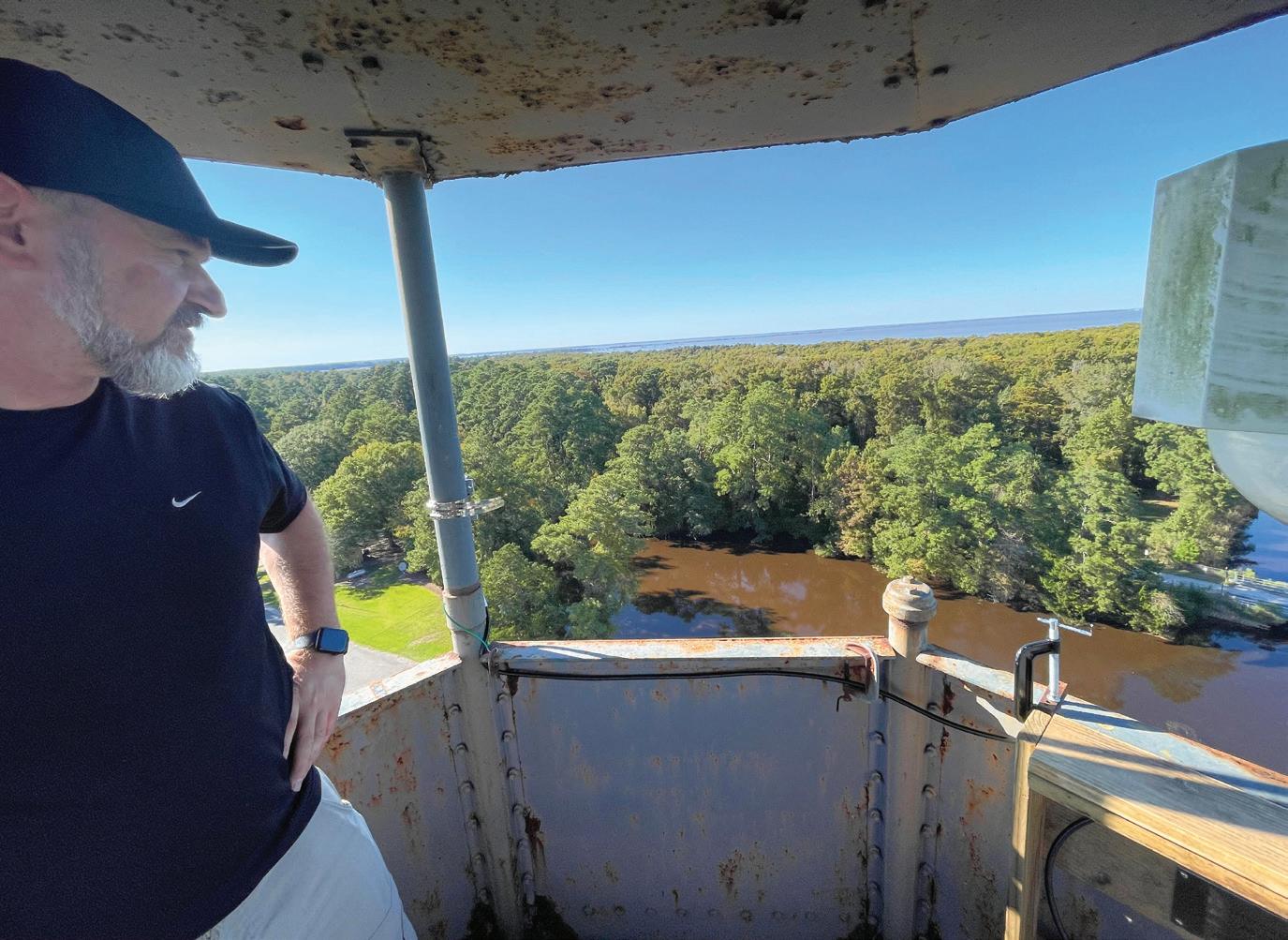
“Think of the sensors as a hotspot, like Apple has for your own personal Wi-Fi, but it can go up to 14 miles in terms of range coverage,” Popoviciu says.
Local farmers have benefited. Popoviciu says he was surprised at how many problems farmers face that could easily be solved with relatively inexpensive technology — less than $100 per sensor.
“Take a farmer in Hyde County. He has to take time out of his day to go out to his irrigation canal, check the water level, turn on the pump, go on with his day, then come back out to the canal at some point to turn the water off. Extremely inefficient. He now has a dashboard on his phone, which displays information from the sensors that tell him when it’s time to turn the water on and off.”
If users see data trends that indicate a problem, experts at ECU stand ready to help.
Popoviciu says his team is working to develop sensor kits and believes the technology will create new jobs for skilled workers to maintain the kits.
“I believe this has a tremendous transformative power for North Carolina. I see this as long-term infrastructure,” he says.
Other AI-focused research projects at ECU include Nathan Hudson in physics, using the technology to process images and extract blood clot structures; Cameron Schmidt with biology, working on sperm analysis to diagnose infertility and potentially provide treatment; Alex Vadati in engineering, working to commercialize an AI technology that can predict pregnancy complications; and Kamran Sartipi in computer science, working
on care monitoring using sensors to remotely determine the well-being of seniors living alone.
Around campus and especially in classrooms, the chief concerns about AI are linked to writing assignments.
“I tell students if they are not certain about a particular use, that they should definitely consult with me first,” says Barbara Bullington, senior teaching instructor in the School of Communication. “Certainly, using AI to cheat on something, like writing a paper, is an issue for all of us. I know I’ve heard other faculty mention that they’ve had instances where students have used AI to write some or all of their paper. I think that’s probably most problematic in the writing area.
“It’s something that in faculty meetings or with emails, the big issue is to make sure we have policies on our syllabi to give students guidance. The ethical side of it is an issue. I really haven’t heard a consensus yet. … But I think most people and faculty in the School of Communication would say to take advantage of it if it’s a good resource.”

Spring 2024 marked the first time an AI-generated image appeared in Countenance magazine, which has been produced by ECU students since 2017 and is printed by The Daily Reflector
The right side of the opening two pages of a feature story about aspiring pediatric physician Alissa Meyerhoffer included a photo of article author Kiarra Crayton and a separate photo of Meyerhoffer writing on a tablet.
On the left was a teddy bear with a stethoscope dangling from its neck – an image generated by the AI program Adobe Firefly.
“AI is a great place for generating content, and it has opened up a lot of creative possibilities. I think we are just at the beginning of that,” says Barbara Bullington, senior teaching instructor in the School of Communication and an adviser for the magazine’s layout.
Brandon Stilley, a reference librarian in Joyner Library, used to resist AI. His views changed when he unexpectedly realized its benefits.
“I had a revelation when I was asked a question on a research topic that I did not understand at all,” he says. “Instead of gathering information from various sources, which would have taken some time, I asked ChatGPT to explain the concepts both individually and as a unified whole. It did a wonderful job of explaining something very complex in a very simple and understandable way. After that, I also discovered that the image generation GPT, DALL-E, had advanced significantly, resolving issues like distorted faces.”
Stilley was instrumental in image generation for the library’s August launch of a digital research guide to AI for students. Bright images fill the guide, which Stilley says is intuitive and a relatively easy process of feeding an idea to an image-generator program and reviewing the image it produces.
“What amazes me most about AI is its versatility,” Stilley says. “It is an equalizer in many ways. While it by no means replaces the talent and effort of traditional artists, it does allow someone like me, who is limited to drawing stick figures with a pen and paper, to communicate through images and display creativity in ways I never could before. It’s also been useful in brainstorming new active-learning activities for the classroom. Additionally, I rely on AI to analyze concepts and generate efficient keywords, a crucial step in the research process.”
In the College of Education, students use AI to spark lesson plan ideas — a practical application. After AI gives teacher candidates lesson plan options that might be effective for their setting, students then analyze the results via their contextual awareness and creativity.
“The information AI generates can often be derivative, predictable or lacking in depth — similar to how Wikipedia provides widely accepted but not particularly inspiring perspectives,” says Todd Finley, coordinator of the English education program. “Because of the limitations of tools like ChatGPT, teacher candidates shouldn’t just outsource instructional decisions to AI. Teachers have more nuanced, cultural and emotional knowledge, which is critical for lessonplanning because kids are made of feelings. Therefore, methods courses are emphasizing a type of critical thinking called curation, where candidates rapidly evaluate, select and organize curriculum.”
Concerns about AI range from the possibility of eliminating the need for human workers to the Hollywoodgenerated idea of a future when AI becomes self-aware and machines dominate the world.
AI is not human. It is a technology designed to mimic certain aspects of human intelligence, but it lacks consciousness, emotions and subjective experiences. AI operates based on algorithms and data rather than human thought or feelings.”
Nic Herndon, a professor in the Department of Computer Science, sees AI as a tool for advancement.
“When it comes to ‘should we fear AI or not,’ I think we should ask ourselves, ‘How can we design AI systems that complement us and help us do things better?’” Herndon says.
David Hart, an assistant professor of computer science, says human adaptation will be important.
“AI is an incredibly powerful digital tool, but it is only as good as the human who directs it,” Hart says. “Just like the internet and the smartphone, AI will change the world in a way that will require each person to rethink how they have done things before. Our future will depend on the ability of individuals and societies to adapt. A lot of people think the danger of AI is that if it gets too smart, it will revolt like we see in the movies. We are far away from that possibility, in my opinion. In reality, AIs are very good at optimizing the goals that we give them, so the true danger is what humans train AI on and how we use it. AI will reflect our desires and our biases.”
Adapting seems inevitable to many experts.
“We owe it to our students to help them navigate this world and understand what these tools can do,” says Zach Loch, ECU’s chief information officer. “And how to best use these tools when they get to the real world, because the truth is they’re going to be using them.”
As Milks moves closer to that real-life scenario of graduation and professional aspirations, she downplays the idea that AI might replace human production.
“Personally, I’m not worried about that,” she says. “AI is only possible because of preexisting work from humans. I think AI can be used as a collaborative tool for designers and artists. Human minds and ideas, in my opinion, are far more impressive than artificial intelligence. AI is not a threat. It’s just another asset we could use to create.”


ECU reference librarian Brandon Stilley created the images above and the one on the opening spread using artificial intelligence.

THE HOMETOWN TEAM WINNING THE 2024 LITTLE LEAGUE SOFTBALL WORLD SERIES WAS A COMMUNITY EFFORT, BUT ECU AND ITS ALUMNI PLAYED A BIG PART
On Aug. 11 at Max R. Joyner Family Stadium at East Carolina University, 13-year-old Anna Rose of the Pitt County team belted a single to right field in the top of the last inning of a scoreless championship game in the Little League Softball World Series.
Teammate Candace Lynn came to the plate. As their assistant coach Brandon Peebles ’00 would say later, the left-hander had been struggling at the plate.
“Coach Percy (Edwards ’87) told me to steal, so I was just focusing on getting to second base,” Anna said. “I had confidence in Candace hitting me in, but at the same time, it was a difficult pitcher to hit.”
She might have been focused, but among the fans who packed the stands and stood in the trees beyond the outfield fence and the TV audience watching on ABC, the situation was tense.
From alumni coaches, to staff and alumni parents, organizers, volunteers and supporters, to the teams riding ECU buses, staying and eating on campus and the finals being played on campus, this would be the championship ECU played a key role in if just one run could cross the plate.

It was a big change from August 2023, when Anna and her mom, Petula Rose ’00, a business systems analyst in financial services at ECU, cheered Anna’s twin sister, Brooke, from the stands at Stallings Stadium at Elm Street Park. That Pitt County all-star team, representing the Southeast Region, would fall to New York in the title game. Anna played the regular season, but didn’t make the all-star team.
“I didn’t really practice over the summer last year,” Anna said. “I just kind of hung out at the beach and focused on the things that I enjoy and came back and was trying to make the team this year.”
So during the Pitt County Girls Softball League regular season, she showed something had changed from 2023, Brooke said.
“She hit the ball better; she was more determined,” Brooke said. She earned her spot, and this year’s team ran roughshod through the district and state tournaments, earning the automatic bid to the World Series as host state champion and representing North Carolina.
The path to this point
In February 2020, Little League announced it was bringing its Softball World Series to Greenville after 26 years at Alpenrose Dairy in Portland, Oregon. The excitement was tempered, however, when Little League canceled that year’s tournament due to COVID-19. The series made its debut in Greenville the following year, but with spectator restrictions.
In 2021, players stayed in local hotels. But the next year, Mark Phillips, who has been a volunteer helping Greenville Little Leagues and the city organize and host the nearly two-week event, contacted Peter Groenendyk, associate vice chancellor for student affairs at ECU, to check about the university’s


ability to house and feed the teams. ECU agreed to it.
“The players can walk to the stadium on Elm Street from our campus, and we can accommodate lodging and meals in one neighborhood,” Groenendyk said in an email. “We take great pride in serving as a host site for the teams. It’s especially exciting to see them arrive from RDU in our ECU motorcoach showcasing our Pirate pride. Hopefully, many of the players will remember the unforgettable experience they had in Greenville and consider returning as a future Pirate.”
Top, Brooke Rose bats against Louisiana in the championship game Aug. 11. Above, assistant coaches Percy Edwards ’87, left, and Brandon Peebles ’00, watch from the dugout. Their daughters Aurora and Emery played on the team. Photos by Aaron Hines

More than 70 years ago, Elm Street Park in Greenville opened with a baseball field and other park amenities. Even a miniature train and a static fighter jet were among the attractions along the way.
But Little League baseball games were the main events.
In 1999, however, Hurricane Floyd washed away the field and inundated the bleachers and concession stand. Volunteers pitched in and rebuilt the field.
But more was coming. Ann Weingartz ’91, whose husband, Brian, serves as Greenville Little Leagues commissioner, tells the story.
“We were hosting a state tournament, and we had just added the inning-byinning scoreboard. So Clark Stallings had come down in August after that state tournament and just happened to be down at the park, saw Brian … and he says, ‘Brian, what’s next? What do you want to do next?’
“Brian’s like, ‘Maybe we’ll brick in the columns like ECU has.’
“And (Stallings) goes, ‘Well, I’m thinking something bigger than that. Anything else?’
“And Brian said, ‘I always envisioned a mini-Guy Smith Stadium here.’” (Guy Smith Stadium is the old-school brick baseball stadium on Memorial Drive in Greenville where Rose High plays its games.)
“And Clark said, ‘Well, that might be something our family would be interested in.’ And (he) literally came back that day with his brother and his mother. That’s kind of how the stadium started.”

The brick stadium with a roof, 234 folding seats and a press box opened in 2012, thanks to the four Stallings brothers – Clark ’89, Jeff ’89, Blake and Billy ’88 – and their $1.14 million donation.
Weingartz says Stallings Stadium was a key selling point in Little League selecting Greenville to host its Softball World Series. None of the other cities that approached Little League had a stadium at their field, she says.

Players watch during a Little League game at Elm Street Park in 1954. In addition to the baseball stadium, the park now features six lighted pickleball courts, three lighted tennis courts, two playgrounds and more.

In addition to providing housing and meals for players, ECU opened its College Hill parking lots for spectator parking. Fans walked the greenway to the city-owned Elm Street Park or rode golf cart shuttles.
Andrew Schmidt ’90, president and CEO of the Greenville Convention and Visitors Bureau, said the tournament has an estimated $1.3 million economic impact for the city in terms of lodging, shopping and dining. During the series, the bureau ran 30-second videos about Greenville on ESPN for households from Georgia to Washington, D.C.
The exposure means as much to the community as the revenue the event generates, he said.
“When you have your championship game … on ABC all over the U.S. and Canada, that’s a big deal,” Schmidt said. “It’s an international event.”
And while Greenville might not be a major city, it’s proved to be the right city.
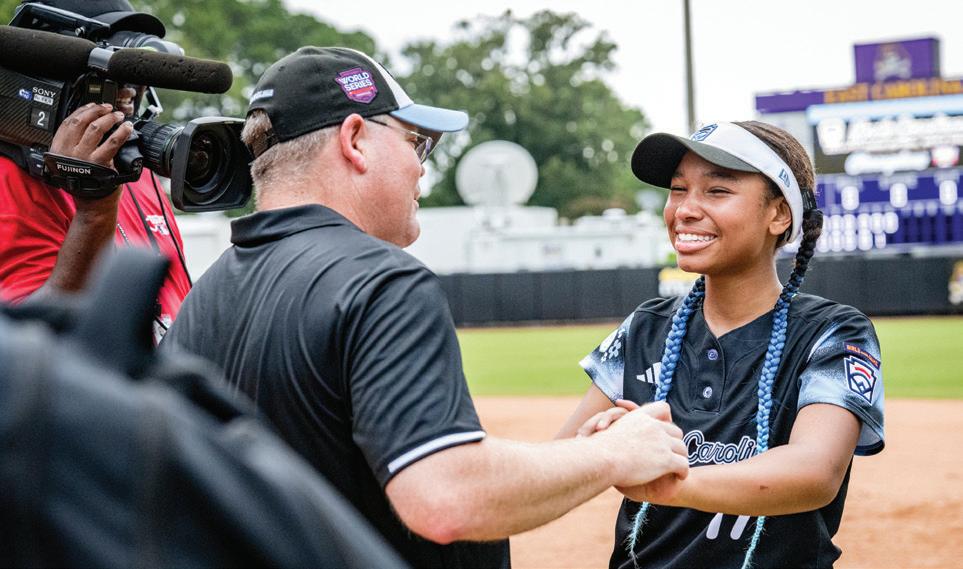
Emery Peebles, daughter of Brandon Peebles ‘00, autographs helmets during a community celebration at the Murphy Center on Aug. 21. The team was also recognized during an ECU football game in September, a visit to the White House in October and at the Musial Awards in St. Louis in November. Coverage from that event will air on CBS on Dec. 29. Photo by Aaron Hines
“We’re big enough, but we’re still small enough,” said Ann Weingartz ’91, director of university printing and graphics. Her husband, Brian, is commissioner of Greenville Little Leagues, and she’s heavily involved. “They were out in Portland where their hotel might be an hour from the field. We have a lot to offer, Greenville as a whole, it being a university town.”
Little League International agreed, announcing last April it was extending the contract to host the series in Greenville through 2027.
At an Aug. 21 community celebration at ECU’s Murphy Center, ECU junior softball player Anna Sawyer and several teammates were there to support the Pitt County team.
“I know a few of these girls have attended some of my games,” she told Kim Grizzard of The Daily Reflector. “But it is really cool that I’m the one getting the autograph from them now. Roles reversed.”
Before signing to play at ECU, Sawyer got her start with the Pitt County Girls Softball League. Her team won the Babe Ruth World Series her 10-year-old year. It was one of 10 the league won during their Babe Ruth days.
The league changed from Babe Ruth to Little League in 2020, the same year Little League announced Elm Street Park as the new home of the Softball World Series.
“People don’t realize in 20 years, we won 10 World Series championships as Babe Ruth,” Bo Batts ’76, PGSL fundraising director, told The Reflector. He led the league for close to three decades and during its switch from Babe Ruth to Little League. “I can’t even count the number of state championships and regionals. I finally had to just pull the plates off (the trophies) and put them on a big board because we ran out of room to store all the trophies. It’s amazing how far it has come in 31 years.”
Batts said having a local team featured in the Softball World Series each of the last three years has benefits for the Pitt County league.
“Having those girls on TV for two weeks, it always results in a boost in our fall enrollment, which carries over to the spring,” he said. Sawyer attended all the local team’s games in the series. She sees the series as a win for softball at every level.
“I feel like Greenville has always been a big softball town,” Sawyer told The Reflector. “But since this has happened, I think from here it’s just going to carry over to our games and high school. It’s definitely going to help softball in general here.”
Pirate spirit overcomes the storm
Though the tournament got off to a good start at Stallings Stadium, after the remnants of Tropical Storm Debby dropped 3.5 inches of rain in four days, the
The team poses at the opening ceremonies Aug. 4. ECU Transit played a vital role in transporting players during the Little League Softball World Series. Photo by Aaron Hines
I feel like Greenville has always been a big softball town. But since this has happened, I think from here it’s just going to carry over to our games and high school. It’s definitely going to help softball in general here.”

Little League teams memorialized Raymond “Raymie” Styons Jr. ’84 following his sudden death Aug. 4. He was 66. Members of the Pitt County team in the Softball World Series wore green ribbons in their hair, while several teams in the Baseball World Series put green stickers on their helmets. Styons managed the Greenville Little League team that won the 2024 12U state championship and went to the Southeast Regional in Georgia. The team lost to Alabama and eventual Little League Baseball World Series champion Florida. Styons died moments after the plane he was returning in touched down at Raleigh-Durham International Airport. Styons, who played baseball at ECU, operated a Greenville insurance agency and was an NCAA Division I men’s basketball official. He had also worked with the Pitt County Girls Softball League and coached youth football. He was looking forward to coaching his grandson Kyle in the upcoming Little League season.

A lot of what it takes to put on a softball world series is obvious: players, coaches, umpires, announcers, concessions staff, a grounds crew, the TV crew. Less obvious is what happens to all those uniforms every night.
That’s where Josh Lilley ’07 and his company, UNX-Christeyns, a global manufacturer of detergents, cleaning supplies and equipment, came in at the Little League Softball World Series.
After each day’s games, his volunteer crew would collect uniforms of the players, coaches and umpires, take them to the Ward Sports Medicine Building at ECU, wash them and then return them.
“Not only do we make the chemicals, we have the expertise of how to get the uniforms clean,” Lilley said.
His wasn’t the usual route to corporate leadership. Founded in Greenville in 1958, UNX grew and prospered, and a few years ago Edwin Clark Jr. ’79 acquired it. At the time, Lilley, who has a music degree from ECU, was a pastor at Ignite Church in Greenville, taught music at South Central and D.H. Conley high schools and coached tennis at Conley. He also started the Fuse ministry at ECU in 2011.
When TideLand Construction, partly owned by members of the Clark family, did some renovations at Ignite, Clark saw how Lilley ran things and offered
him the head role at UNX. “There was this business mindset that I wasn’t aware of,” Lilley said.
In 2022, the company merged with Christeyns USA, part of the Belgium-based manufacturer of cleaning supplies, and became UNX-Christeyns.
The laundry equipment in Ward is already programmed for UNX-Christeyns products, so that made it a little easier. Still, on days like Aug. 9, when six games were played on a clay infield that had gotten two days of rain – and some teams played twice – there were challenges.
“They did require some scrubbing,” Lilley said of the uniforms. His group worked past midnight getting everything clean and back to the teams.
The latest product from UNX-Christeyns is Hook and Hand, a hand-hygiene product that’s being distributed around ECU facilities. Fifty percent of the net proceeds go the Boneyard Collective NIL organization.
UNX-Christeyns supplies its products and technologies to half of Major League Baseball teams and 20% of NFL and NBA teams. That means a lot of eyeballs are seeing the company’s results almost every day, giving them a lot of motivation to get results.
“If someone’s talking about laundry, it’s probably not good,” Lilley said.


field was unplayable. As a result, Little League canceled games on Wednesday and Thursday and moved the rest of the tournament to Max R. Joyner Family Stadium at ECU. Teams played a whopping six games Friday, two Saturday and three Sunday, including the championship. More rain poured shortly after the title game celebrations ended.
“Given the relationship with the city, Little League International and the institution, when Little League asked us about hosting games Friday and Saturday at Joyner Stadium to give Elm Street time to dry, we said yes,” said JJ McLamb ’01 ’06, executive associate athletic director at ECU. The university had already hosted the Athletes Unlimited pro softball game Aug. 7 as part of the World Series events. (It got rained out after two innings.) “When
MORE INFO Watch highlights of Pitt County’s semifinal against Pennsylvania at bit.ly/3Ae3w56 and the championship against Louisiana at bit.ly/40rGu5z.
they realized Elm Street was not going to be playable on Sunday for the championship game, they asked us to host the championship game.
“It was wonderful. We’re looking forward to assisting and it returning to Stallings Stadium.”
“It’s such an amazing partnership,” said Batts. “I don’t know what they would have done without that gorgeous facility just a mile away.”
LaDarrius Madison, manager of the Louisiana team, praised ECU. “This campus here, it kind of reminds us of LSU with all the purple and gold,” he said. “But the campus is beautiful. The facilities, I mean, just the welcoming here, the workers here, everybody.”
Greenville Recreation and Parks had already planned drainage improvements at Elm Street once fall baseball ended. After the World Series, Don Octigan, executive director of city parks and recreation services, said those plans were still in place and may go further than originally planned.
Back to Anna at first. It wasn’t the first time that day she’d been in position to score the winning run. In the morning against Pennsylvania, she stood at third when Emma Pilgreen grounded out to second, scoring Anna and giving Pitt County a lead they wouldn’t relinquish in the 1-0 game.
So there she was, bottom of the fifth, two outs, focused on stealing second.
One pitch, and Candace stretched out and hammered it over the left fielder’s head.
“When she hit the ball, my legs felt like Jell-O, and I wanted just to like walk, but I didn’t,” Anna said. She rounded third and crossed the plate with ease. When Louisiana didn’t score in the top of the sixth inning, the celebration erupted.
Edwards, an assistant coach, said Anna missing the team in 2023 was reflected in her play in 2024. “It made her work harder. She came out with a big hit. She got on first base, and Candace drove her in. That was big. That was huge. Sometimes disappointment will make you jump up, dust off and go forward,” he said.
Candace had just two hits the whole tournament before that fateful one Sunday, against four strikeouts and two walks.
“I didn’t know where it was going to go. I was just trying my best to hit it for my team,” said Candace, who wants to be a doctor and has ECU on her list of colleges where she’ll pursue that dream. “We were really down, and our energy was really low. We were just trying to hype each other up just to get someone to step up and be big. I’m really proud. I’m proud of my team. The fact we represented our hometown means a lot.”

Hometown: Dudley, North Carolina
Class: Junior
Major: Engineering, concentration in electrical engineering
Career goals: To work on medical devices or with prosthetics
Joshua Williams may not be taking the fast lane toward an engineering degree, but the junior knows he’s on the right road.
After financial difficulties derailed his first attempt at college in 2006, he worked odd jobs and drove trucks for about 5 1/2 years before asking himself some questions.
“Where am I supposed to be going? What direction am I supposed to be going in? I know I have purpose, but I just don’t know what to do,” he said. “I want to chase purpose instead of money.”
He says his wife, Sara, motivated him to attend Wayne Community College. While there, he was accepted into ECU’s PIRATES engineering scholarship program.
“It has been a huge help and relief so that way I don’t have to work as hard outside of school to be able to take care of what I need to in school,” he said.
With an electrical engineering concentration, Williams wants to work in the medical field.
“This world is bigger than me, and my life is bigger than me, and I just want to be able to help others and expand on my purpose,” he said.
He sees a comparison between driving a truck and his education.
“In a truck, you’ve got to stay in your lane and stay focused on what you’re doing to get to your goal, and I feel like in engineering, you need to do the same thing,” he said.
He’s a member of the Phi Sigma Pi honor society.
“I’m just a simple guy, and I’m just trying to make an impact on the world the best that I can because I love to help people,” he said. “I just like to see people happy.”
– Ken Buday
Emmy Award-winning biologist and wildlife conservationist Jeff Corwin, perhaps best known for hosting Going Wild with Jeff Corwin on the Disney Channel, brings his message of Earth’s wild species and the challenges they and the environment face to ECU when he presents “Tales from the Field with Jeff Corwin” on Jan. 30 in the Main Campus Student Center Ballroom. Corwin also

is the creator, executive producer and presenter of the ABC television series Wildlife Nation, which explores the story of North American conservation, and is the author of 10 books on wildlife and nature, including Living on the Edge: Amazing Relationships in the Natural World
Tickets are available at ecu.edu/voyages.
Patsy Cline, Loretta Lynn, and Dolly Parton revolutionized country music and blazed a trail for future generations of female artists.
Trailblazing Women of Country pays homage to those artists who have shaped and defined the genre throughout its history. This dynamic group of contemporary artists featuring soloist Miko Marks of CMT’s 2022 Next Women of Country and Nashville-based singer Kristina Train, supported by a five-member female band, continues the tradition of breaking boundaries and pushing the genre forward. Feb. 22

The New York Theatre Ballet, a renowned institution in the world of dance, has earned recognitions such as the National Endowment for the Arts Award and the

Governor’s Arts Award. Beyond their graceful movements on stage, their outreach programs bring the magic of dance to communities, schools and diverse audiences. Whether you’re a seasoned enthusiast or new to the dance scene, the New York Theatre Ballet promises an unforgettable experience that transcends the boundaries of the stage. March 22

From their inception in the early 1950s, the story of The Drifters has covered the entire spectrum of rock & roll. They were the first musical group to incorporate string instruments into rhythm & blues with their song “There Goes My Baby.” They were the first musical group to sell 2 million records with their pop classic “Up on the Roof.” And they were the first African-American vocal group to be inducted into the Rock & Roll Hall of Fame. April 25

No one believed in Joan of Arc’s visions, but that didn’t deter her from leading France to reclaim its homeland. In Wild Heart, witness the power of belief with Chelsea Marcantel’s thrilling new musical adaptation with modern hits by P!nk, Kelly Clarkson, Melissa Etheridge and more. This presentation of this new, original work will be the first on any stage. Feb. 19-22 at 7:30 p.m. and Feb. 23 at 2 p.m.

Aaron Posner flips The Seagull on its head in Stupid F**king Bird, a new adaptation of Chekhov’s masterpiece. It’s the story of a nubile young performer and an aging Hollywood actress who battle for the attentions of a successful novelist, while an aspiring playwright rages against the art of his mother’s generation. With original songs by James Sugg to give a glimpse into the inner thoughts of Chekhov’s characters, Stupid F**king Bird will spur audiences to consider how art, passion and innovation inspire realization. April 23-26 at 7:30 p.m. and April 27 at 2 p.m.

A mesmerizing dance extravaganza, Spring Dance ’25 showcases expert choreography and rising talents. Get ready to witness the seamless fusion of contemporary, modern, ballet, jazz and tap dance in one unforgettable performance. March 26-29 at 7:30 p.m. and March 30 at 2 p.m.
Performances are in McGinnis Theatre. Tickets are available at tickets.ecu.edu or by calling 252-328-6829.
The ECU School of Music will present music and readings in remembrance of the Holocaust on Jan. 27 at 7:30 p.m. at A.J. Fletcher Recital Hall. Free and open to the public.
The ECU Symphonic Wind Ensemble and Jazz Ensemble perform Jan. 31 at 7 p.m. in Wright Auditorium. Free and open to the public.
ECU’s Four Seasons Chamber Music Festival presents Behind the Scenes with The Cooperstown Quartet on Feb. 14 at 7:30 p.m. at A.J. Fletcher Recital Hall and Feb. 16 at 3 p.m. at Hayes Barton United Methodist Church in Raleigh. On March 21, they perform Tours de Force at 7:30 p.m. at A.J. Fletcher and March 23 at 3 p.m. at Hayes Barton. On May 2, they present Two Beginnings at 7:30 p.m. at A.J. Fletcher and May 4 at 3 p.m. at Hayes Barton.
The North Carolina NewMusic Initiative presents Premiere Performances composed and performed by students Feb. 6, March 6 and April 8 at 7:30 p.m. at A.J. Fletcher Recital Hall. Free and open to the public.
For more information about these and other musical performances, call 252-328-6851 or visit music.ecu.edu. Livestreams are available at youtube.com/ecuschoolofmusiclive.
EXHIBITS

Faculty and guest artists Catherine Gardner, soprano, and Catherine H. Garner, piano, perform Feb. 17 at 7:30 p.m. at A.J. Fletcher Recital Hall. The ECU Symphonic and Concert Bands perform Feb. 18 at 7:30 p.m. in Wright Auditorium. The ECU Symphonic Wind Ensemble with the Havelock High School Wind Ensemble performs March 3 at 6:30 p.m. in Wright Auditorium.
The ECU Collegiate Choir performs April 15 at 7:30 p.m. at A.J. Fletcher Recital Hall. ECU Chamber Singers perform Feb. 28 at 7:30 p.m. at St. Paul’s Episcopal Church in Greenville. The Chamber Singers, University Chorale and Concert Choir perform there April 25 at 7:30 p.m. Free and open to the public.
The ECU Symphony Orchestra is in concert Feb. 8, March 1 and April 12. Performances are at 7:30 p.m. in Wright Auditorium and are free and open to the public.
Jazz performances, part of the Billy Taylor Jazz Festival, will be March 24-26 and March 28 at 8 p.m. in Fletcher Music Room B110. The ECU Jazz Ensemble takes the stage March 29 for the Billy Taylor Jazz Festival Gala at 8 p.m. in Wright Auditorium. Free and open to the public.
The Materials Topics Symposium Exhibition is on view Jan. 3-24. The Scholastic Arts Awards Exhibition is Feb. 6-22 From April 4-17 the Spring 2025 BFA Senior Exhibition 1 will be on view, and Exhibition 2 is April 28-May 9. The School of Art and Design Faculty Exhibition is March 7-28
Exhibits are at the Wellington B. Gray Gallery inside the Jenkins Fine Arts Center. For information, call 252-328-6665 or visit art.ecu.edu/artonline/gray-gallery.
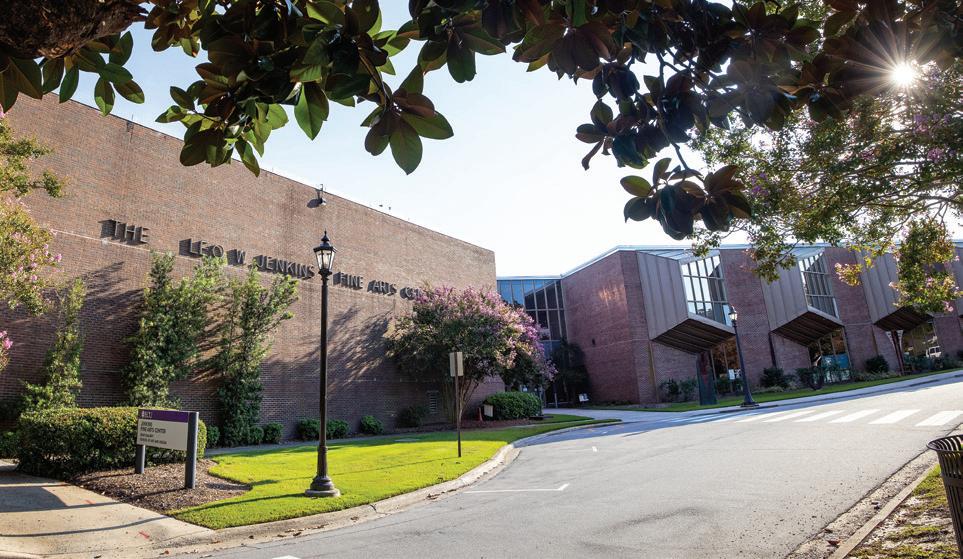

A flash of Pirate-inspired flare adorns every can from Hancock Peanut Company. The purple stripes on the logo of the golden legumes highlight the talents and family history of Scott Hancock Duke ’06 ’08.
Duke lives in Greenville and runs a digital marketing business where he manages his clients’ website design and social media marketing needs. The work fuels his passion project.
Duke launched the company in 2023 and began a new retail chapter in his family’s peanut business history. Peanuts were not in his career plans when Duke was completing degrees in media production and health communications in the College of Fine Arts and Communication. Still, the family business and history were always on his mind.
Most people would be unaware they have a passing knowledge of Hancock Peanut Company. Duke’s great-grandfather, Robert Hancock Jr., created the original peanut man model that became known as Mr. Peanut.
Duke said his great-grandfather was asked by the owner of Planters to carve the model from a sketch.
Large wrought-iron statues of Mr. Peanut topped the pillars around the factory in Suffolk, Virginia.
Hancock also built a peanut sheller and started Hancock Peanut Company in Courtland, Virginia. They were buyers, sellers and shellers of high-grade Virginia peanuts. His shellers are in museums in Virginia.
“He didn’t seek patents. He was an industrialist trying to figure out how to make something work and more interested in the next steps than thinking
At left, ECU alumnus Scott Duke kick-started a retail brand of Hancock Peanuts. Below, peanut and Pirate fans can learn more using this QR code.


about down the road,” Duke said. “Today’s peanut shellers are a modernized version of the original.”
Duke researched the company name and history and found the name available. He trademarked it and kickstarted the new retail brand.
Antique peanut jars and company memorabilia accent Duke’s home. They inspired his designs for the company’s new logo.
He’s built the business from the ground up. He processes orders, sells swag and writes a peanut news blog. He’s worked with local vendors to create peanut-themed shirts, caps and a Hancock Peanut Co. tumbler.
Duke says the jumbo peanuts selected for sale are from the top 1% of the crop, grown in Virginia and the Carolinas. The salted cocktail peanuts are his No. 1 seller. Chocolatecovered peanuts and a honey-roasted version launched last winter and quickly became fan favorites.
“People like peanuts. They are really fantastic,” Duke said. “Anyone who tries them comes back to order more.”
He gained ECU trademark licensing and created limitededition “Proud Pirate Peanuts” for the ECU Alumni Association and entered a partnership with Team Boneyard, which supports ECU student-athletes.
Duke is working to grow his footprint throughout Pirate Nation. He aims to find an investor or partner and establish a distribution effort to get Hancock Peanuts on shelves in North Carolina retailers and more.
Greenville-based MrBeast recently placed a $1,000 order, and the former wardrobe manager for Seinfeld served Hancock Peanuts for a cast/crew/writers party in the fall.
Learn more about the company and peanut history at hancockpeanuts.com.
– Patricia Earnhardt Tyndall

Dana Reed Fox ’07 learned valuable lessons as a construction management student at ECU. As the chief operating officer of Richmond (Virginia) Public Schools, she puts those lessons to work making sure 22,000 students have the proper facilities in which to learn.
“Every part of the work affects student achievement,” Fox said. “Whether it’s building an entirely new school, transporting students to and from school, installing technology or repairing building equipment — all of these things impact learning, and it makes the work incredibly meaningful and also incredibly important.”
Her biggest project — and the one she’s most proud of — involves the rebuilding of William Fox Elementary School after a fire destroyed the 100-year-old building in 2022.
“Walking through the building after the fire had been extinguished is a memory I will never forget,” Fox said. “Charred backpacks and children’s coats that were still hanging in burnt-up classrooms, the amount of catastrophic damage that the water caused from extinguishing the flames, the personal teacher items like photos, posters and trinkets either soaked or melted — it was really powerful and emotional to experience, but I knew the work had to start to bring it back to life.”
She says school system, community and legislative support have been crucial in getting the school rebuilt, with a scheduled opening in the fall of 2025.
“The process of rebuilding this school and the impact on the community are something I will forever be grateful to be a part of,” Fox said.
While in commercial construction, Fox helped with the first Leadership in Energy and Environmental Design building on the campus of James Madison University. LEED is a framework for more energy-efficient and cost-saving green buildings, a method Fox supports in her work in Richmond.
“It has become a building standard, and while the target does continue to move and the costs continue to increase, I do think healthy, sustainable buildings are valuable and important,” she said. Fox lives in Chesterfield, Virginia. A mother of five, she’s the youngest COO in the school division’s history and oversees a staff of 4,500. She was named an Emerging Leader for the Southeastern Association of School Business Officials and was recognized with an RVA BizSense Power Women Under 40 award. She credits her ECU education for giving her a great foundation.
She graduated from ECU at a time when, she said, few construction management majors were women.
“Even as the only female in most of my classes, it helped shape how I continue to scale the mountain in a male-dominated field,” Fox says. “While the numbers of women in the industry are increasing, there is still a lot of work to do, and my passion is sharing my journey with others and advocating for gender equity.”
Looking back, she said the campus energy and atmosphere drew her to ECU, and she feels honored to be a graduate.
“ECU was truly the best decision I could have made,” Fox said. “And I tell everyone that any chance I get.”
– Ken Buday

It’s safe to say Noah Holmes was born to play football at ECU.
“I’ve been coming to games since I was in the womb,” he said. “Up until my junior year of high school, I came to every home game.”
ECU, and specifically ECU football, is deeply ingrained in Holmes. His father, Joe, played defensive tackle in the late 1980s, and his grandfather, Randall, played multiple positions for the Pirates in the late 1950s. Holmes has had more than 20 family members attend ECU, including his younger brother Luke, a freshman defensive lineman.
“They talked about how football has changed,” Holmes said of stories from his father and grandfather. “My dad would tell stories about who he played with. My grandfather told stories about playing at ECU, getting drafted into the military, and then came back to play and graduate.”
An all-region player at Warhill High School in Williamsburg, Virginia, Holmes began his collegiate career as a linebacker at the University of Richmond for two seasons before transferring to James Madison. Holmes earned his bachelor’s degree last spring but still had a year of eligibility. Additionally, ECU was recruiting Luke, and it had been a dream to play together.
“As a kid I always wanted to play for ECU but wasn’t sure how it would play out,” he said. “When I left JMU, this was the only school I had in sight.”
Holmes contacted Blake Harrell, ECU’s defensive coordinator and linebackers coach at the time, about the opportunity to try out for the team. Holmes had previously tried out for the team and made the squad but got hurt and then transferred to Richmond.
“The effort he plays with and what he shows is huge,” said Harrell. “He’s

a good example for our younger guys of treating his job in our program like a professional. It’s special that a kid grows up an ECU fan, has all of the connections to our program and is able to follow in those footsteps.”
Holmes is pursuing his leadership in organizations graduate certificate.
– Steven Grandy
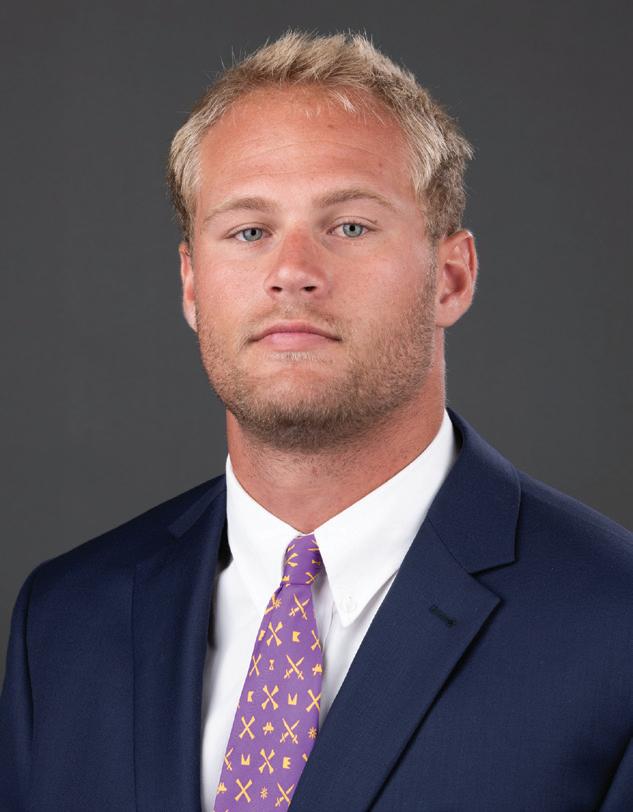
Noah Holmes
Year: Graduate student
Major: Leadership in organizations graduate certificate
Hometown: Williamsburg, Virginia
I’VE BEEN COMING TO GAMES SINCE I WAS IN THE WOMB. UP UNTIL MY JUNIOR YEAR OF HIGH SCHOOL, I CAME TO EVERY HOME GAME.

5 minutes with
By Patricia Earnhardt Tyndall
Position:
Executive vice president and chief technology officer, National Association of Broadcasters
Degree: Communication, business minor
Resides: Beaufort, North Carolina, and Washington, D.C.
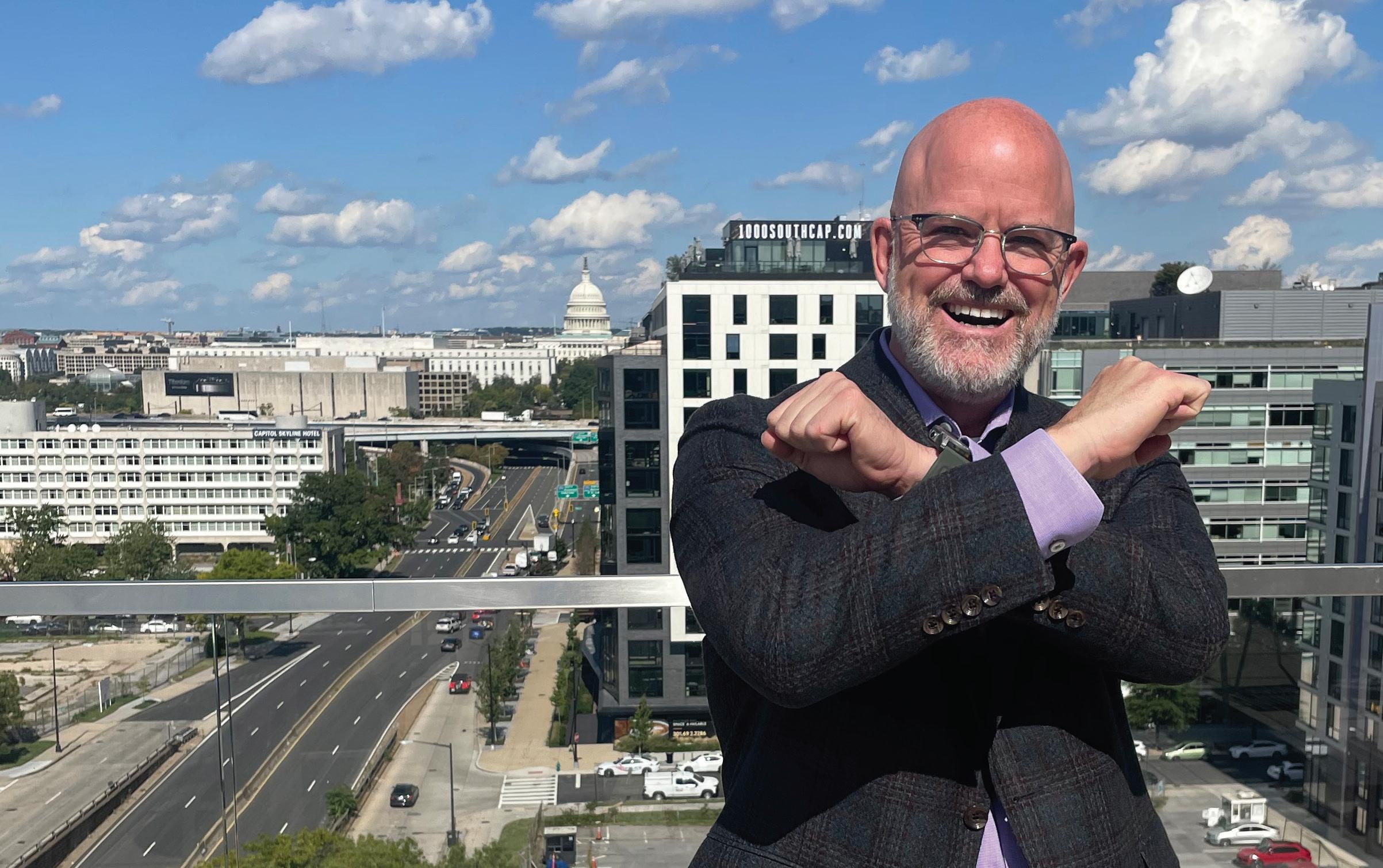
Briefly describe your job responsibilities.
I lead the NAB technology team. We help radio and television broadcasters thrive in a multiplatform digital media world by developing standards, advocating for technology adoption, promoting international collaboration and developing educational programming.
What led you into this career?
My professional life has been spent at the nexus of broadcasting and the Internet. I worked for Capitol Broadcasting building websites, designing mobile applications and deploying digital cinema. That work took me to D.C. to advocate for projects that we were pursuing, and I began visiting and working with the NAB and other agencies.
What’s most rewarding about your job?
Working on large-scale innovation and technology projects with national and even global impact. At NAB, I basically serve as a futurist and a change agent.
What are you working on that you’re most excited about right now?
I’m working on the Broadcast Positioning System. BPS works a lot like GPS, but it uses TV transmissions instead of satellite, and it can solve a trillion-dollar national and economic security issue for our nation. GPS is fragile and easily jammed, spoofed or disrupted, and BPS can augment and improve GPS as a terrestrial service.
What professor at ECU influenced you most in a positive way?
My favorite class was Dr. Ernest Phelps’ politics and the media. He was so thoughtful and focused on making sure his students developed a real and meaningful understanding of the world around us. We read From Whistle Stop to Sound Bite, which explored the relationship between television and politics. I guess it is fitting that I’m now working for broadcasters in Washington.
We want to hear stories from alumni about how their experiences at ECU shaped them today and how they pass those lessons to others. Send us an email at easteditor@ecu.edu

What do you like most about your major?
With both animation and photography, I appreciate the ability to dive into sensitive/emotional narratives and, in a sense, add my interpretation of reality. Creating narratives behind my work gives me a reason to be drawn to what I do and create. I also appreciate how my concentrations push me to create something new with every project, thus stretching my imagination and prompting me to make mistakes and try again.
Receiving a scholarship shows me there are others who actively want to support me and my work. Obtaining financial support behind my art education motivates me to continue to create art, challenge myself and go far beyond my limits. Knowing the art I hold close to my heart earned me this scholarship encourages me to create even greater art in the future and renew myself into a finer artist.
Through several years of applying for and obtaining scholarships, I learned of their importance in supporting my educational goals. Alumni, depending on their
Hometown: Washington, D.C.
Major: Fine arts with concentrations in animation and photography
Career goal: Illustrator, photographer
Scholarship: Kathy Adams White Scholarship
circumstances, have the ability to further the education of college students like me. I am very thankful to the alumni who have contributed to funding the scholarships I’ve earned. I see the importance of alumni supporting scholarships as this especially affects disadvantaged students in need of financial assistance.
Kathy Adams White ’75 earned a bachelor’s degree in art from the College of Fine Arts and Communication. White taught art for several years in Wake County. She established the Kathy Adams White Scholarship Endowment for immediate use to support students from eastern North Carolina. Additional funding will be provided through a charitable remainder unitrust. The scholarship is available annually to support undergraduate students majoring in art or art education in the School of Art and Design. give.ecu.edu
East Carolina University’s Pirate Entrepreneurship Challenge has a new name and an investment that will boost prize money and the student experience for the university’s signature pitch competition.
Through a $3.2 million gift from Helen Aman and family supporting the Miller School of Entrepreneurship, the College of Business renamed the signature pitch competition in memory of Gene Aman ’65. The Gene T. Aman Pirate Challenge will provide more opportunities for participation, larger cash gifts and the ability to expand its reach and influence across the campus and in eastern North Carolina.
Sharing the announcement of the “transformational gift,” Chancellor Philip Rogers cited the contributions of ECU trustee Fielding Miller ’84 and his wife, Kim, for the gift that established the only endowed school of entrepreneurship in the UNC System.

“We thank you (all) for your investment and for bringing us to this moment,” Rogers said. “The generosity of so many Pirates helps us make this happen and helps us fulfill this work as a university community. It’s because of great individuals who have demonstrated their trust in ECU that we’re able to sustain (the challenge) over the long term.”
Miller said the total capital raised for the Miller School eclipsed $20 million with the Aman family investment.
“We’ve had a lot of people step up financially and invest in this idea,” Miller said. “To honor Gene, the family has made a substantial donation and today we are announcing that the Pirate Challenge is now the Gene T. Aman Pirate Challenge.”
Aman was a business major who had a passion for business and entrepreneurship, Miller said. He shared an interest in business with childhood friend James Maynard ’65. Aman became one of the founding investors in Golden Corral with Maynard. He died in 2022.

Established in 2018, the Pirate Challenge has awarded more than $900,000 in cash prizes and in-kind services to more than 25 student-led teams representing many of ECU’s schools and colleges.
Michael Harris, dean of the College of Business, celebrated the Aman gift, its impact on experiential learning at ECU and its power in elevating an entrepreneurial culture on campus.
“This signature competition plays a significant role in how the Miller School serves as a national model for building a comprehensive entrepreneurship program,” Harris said. “The cumulative effort to get to this point has been created by ECU entrepreneurs who see the College of Business, the Miller School and now the Aman Challenge as the incubator of the next generation of Pirate entrepreneurs.”
– Patricia Earnhardt Tyndall

Nell Barnhill ’47 of Elizabethtown, N.C., on April 30, 2024.
Ruth S. Gardner ’48 of Winston-Salem, N.C., on April 26, 2024.
Evelyn Gray Knowles ’46 of Wilson, N.C., on May 31, 2024.
Dixie Porter ’44 of Cary, N.C., on June 8, 2024.
Reba Quinn ’44 of Warsaw, N.C., on June 27, 2024.
James R. Worsley Jr. ’44 of Washington, D.C., on July 1, 2024.
Thelma J. Allen ’57 ’59 of Winterville, N.C., on March 18, 2024.
James W. Alexander ’55 of Abilene, Texas, on July 15, 2024.
Peggy J. Ayers ’57 ’59 of Washington, N.C., on May 10, 2024.
Ruby U. Briley ’55 ’60 of Chapel Hill, N.C., on July 18, 2024.
John S. Byrd ’59 of Wilson, N.C., on July 17, 2024.
Evelyn S. Cheek ’55 of Chapel Hill, N.C., on April 13, 2024.
Mercedes Ervin-Schoppaul ’59 of Greenville, N.C., on March 16, 2024.
William N. Fowler ’57 of Colerain, N.C., on March 18, 2024.
Grady Gaskill ’52 ’53 of Grandy, N.C., on June 18, 2024.
Whitaker B. Ham ’53 of Norfolk, Va., on July 23, 2024.
Anne Linville ’59 of Clovis, N.M., on March 26, 2024.
Robert A. Mays Jr. ’51 of Aurora, N.C., on May 30, 2024.
Paul Popov ’57 of Athens, Ga., on July 2, 2024.
Alton G. Ross ’58 of Durham, N.C., on March 10, 2024.
Jo Ann Rouche ’54 of Chattanooga, Tenn., on April 4, 2024.
Ernest W. Taylor ’57 of Greenville, N.C., on Feb. 29, 2024.
Evelyn Truell ’51 of Southmont, N.C., on April 10, 2024.
Richard Baldree ’62 of Eros, La., on June 14, 2024.
Jane Banister ’69 of Suffolk, Va., on April 9, 2024.
Lee W. Brinson ’65 ’67 of Richmond, Va., on May 24, 2024.
Brenda S. Brown ’62 of St. Augustine, Fla., on March 23, 2024.
Wilbur Castellow ’61 ’63 ’64 of Washington, N.C., on May 17, 2024.
Carolyn Elam ’60 of Brunswick, Ga., on May 28, 2024.
Nancy L. Early ’64 of Williamsburg, Va., on June 1, 2024.
Madge Ferguson ’69 of Blairsville, Ga., on April 13, 2024.
Donald R. Franks ’67 ’73 of Wilson, N.C., on March 26, 2024.
Granville Gainey Jr. ’66 of Salemburg, N.C., on April 10, 2024.
Earl D. Hart ’61 ’65 of Gainesville, Fla., on July 15, 2024.
Henry B. Jackson ’66 of Southern Pines, N.C., on July 24, 2024.
Jackie S. Johnson ’69 of Trent Woods, N.C., on June 28, 2024.
Marion W. Kirby ’65 of Greensboro, N.C., on June 29, 2024.
Kerry Lueck ’68 ’73 of Santa Fe, N.M., on May 7, 2024.
Gail G. Lung ’68 of Greensboro, N.C., on March 25, 2024.
Martha Marcom ’61 of Raleigh, N.C., on July 29, 2024.
Bobby S. McKee ’67 of Deland, Fla., on April 12, 2024.
John P. Mitchell ’66 of Tampa, Fla., on March 17, 2024.
J. Reid Parrott Jr. ’60 ’62 of Greenville, N.C., on April 21, 2024.
Ann B. Peaden ’62 of Greenville, N.C., on June 26, 2024.
Jean F. Person ’65 of Greenville, N.C., on July 7, 2024.
Frances B. Phillips ’68 ’78 of Morehead City, N.C., on April 2, 2024.
Melbourne “M.H.” Pridgen ’60 ’61 of Rocky Mount, N.C., on July 3, 2024.
Richard L. Pursley ’67 of Greensboro, Md., on March 20, 2024.
Douglas Robinson ’64 of Roxboro, N.C., on June 15, 2024.
Wiley B. Rogerson ’66 of Robersonville, N.C., on April 27, 2024.
Annie M. Rountree ’69 ’70 of Gates, N.C., on June 23, 2024.
Robert Rynearson ’69 of El Cajon, Calif., on April 25, 2024.
Elizabeth Ross ’64 ’65 of Greenville, N.C., on March 26, 2024.
Gerald B. Rowland ’64 of Rocky Mount, N.C., on July 15, 2024.
Lorraine V. Russell ’61 of Hookerton, N.C., on May 8, 2024.
John Sampredo ’63 of Citrus Hills, Fla., on July 1, 2024.
Peggy B. Silvester ’69 of Jacksonville, N.C., on July 17, 2024.
Dianne Skaperda ’61 of Raleigh, N.C., on March 21, 2024.
Patricia Smith ’68 of Fairfax Station, Va., on July 9, 2024.
Janet M. Stone ’65 of Winston-Salem, N.C., on May 27, 2024.
Peggy B. Silvester ’69 of Jacksonville, N.C., on July 17, 2024.
Blarney Tanner Jr. of Rocky Mount, N.C., on July 29, 2024.
Christine L. Wilkerson ’66 ’91 of Montgomery, Texas, on July 30, 2024.
Ted M. Williams ’62 of Durham, N.C., on April 27, 2024.
James G. Wood Jr. ’65 of Sanford, N.C., on Feb. 27, 2024.
John S. Barber ’78 of North Augusta, S.C., on May 11, 2024.
William R. Barnes ’73 of Battleboro, N.C., on April 2, 2024.
Andy Beacham Jr. ’74 of Washington, N.C., on May 3, 2024.
Robert Bell ’78 of Goldsboro, N.C., on June 6, 2024.
John E. Blake ’77 of Durham, N.C., on March 23, 2024.
Jerry W. Bobbitt ’75 of Blounts Creek, N.C., on April 2, 2024.
Shelton Bond ’70 ’80 ’84 of Greenville, N.C., on April 6, 2024.
Troy Bone ’75 of Cape Carteret, N.C., on June 19, 2024.
Margaret R. Boykin ’70 of New Bern, N.C., on June 11, 2024.
Michael S. Buck ’73 of New Bern, N.C., on March 23, 2024.
Shelby V. Bullock ’72 ’85 of Greenville, N.C., on June 29, 2024.
Edward E. Callis ’71 of Matthews, N.C., on May 10, 2024.
Julia Capps ’72 ’76 of Sanford, N.C., on April 24, 2024.
Stephanie Carlson ’70 of Charlotte, N.C., on Oct. 6, 2023.
Rebecca Clayton ’71 of Pompano Beach, Fla., on April 11, 2024.
Gail O. Cobb ’72 of New Bern, N.C., on May 31, 2024.
Lois Dunnigan ’74 of Wanchese, N.C., on March 27, 2024.
Stephanie T. Ezzell ’79 of Raleigh, N.C., on March 20, 2024.
Kenneth Finch ’70 of Olympia, Wash., on June 18, 2024.
Susan F. Fox ’77 of Kinston, N.C., on April 13, 2024.
Julia Green ’76 of Charlotte, N.C., on March 13, 2024.
Linda C. Griffin ’70 ’84 ’92 of Jacksonville, N.C., on Aug. 20, 2024.
William Hamnett Jr. ‘70 of Richmond, Va., on June 4, 2024.
Coby S. Heath ’73 of Greenville, N.C., on June 6, 2024.
Joanne C. Heidenreich ’77 ’80 of Goldsboro, N.C., on March 5, 2024.
Beverly D. Holt ’72 of Bath, N.C., on March 20, 2024.
Charles L. Kelly ’76 of Sanford, N.C., on July 25, 2024.
Charles Kinlaw ’73 of Lumberton, N.C., on May 29, 2024.
William Langley ’72 of Charlotte, N.C., on June 23, 2024.
Raymond Linville ’74 ’77 of Clearwater, Fla., on June 2, 2024.
Jane Lockerman ’72 of Gasburg, Va., on June 2, 2024.
Jerry Long ’72 of Raleigh, N.C., on April 18, 2024.
Ron C. Lowry ’77 of Winston-Salem, N.C., on July 15, 2024.
Harrison G. McHugh Jr. ‘74 of Greenwood, S.C., on June 23, 2024.
Kathryn McKinney ’78 of Winston-Salem, N.C., on June 9, 2024.
Steven Michael ’71 of Chapel Hill, N.C., on June 10, 2024.
Nancy Morris ’77 of Valdosta, Ga., on March 1, 2024.
Joyce G. Nelson ’70 of Holly Ridge, N.C., on May 24, 2024.
Carolyn Newcomb ’70 ’73 of Snow Hill, N.C., on Feb. 27, 2024.
Gerald Peterson ’71 of Southern Pines, N.C., on March 6, 2024.
Robert K. Rausch ’78 of Waldorf, Md., on March 27, 2024.
Reba Ray ’70 of Raleigh, N.C., on April 30, 2024.
Sidney Redding ’75 of Fayetteville, N.C., on March 31, 2024.
Thomas R. Shore ’75 of Chapel Hill, N.C., on July 26, 2024.
Mae N. Shugart ’74 of Greenville, N.C., on May 22, 2024.
Rex E. Spurgin ’77 of Greenville, N.C., on March 16, 2024.
Linda A. Swaim ’78 of Thurmond, N.C., on April 6, 2024.
Terry V. Thomas ’75 of Washington, D.C., on May 27, 2024.
Margaret S. Wells ’71 of Virginia Beach, Va., on March 21, 2024.
Jean R. Whitsett ’73 of Yadkinville, N.C., on April 19, 2024.
Noah Woods ’72 of Pembroke, N.C., on March 29, 2024.
Wanda Wrightson ’73 of Plymouth, N.C., on April 6, 2024.
Michael H. Cooper ’82 of Sanford, N.C., on May 24, 2024.
Susan B. Corbett ’80 ’86 of Belmont, N.C., on Feb. 2, 2024.
James A. Eason Jr. ’81 of Rogers, Ark., on March 5, 2024.
Donna Harrell ’82 of Swansboro, N.C., on June 7, 2024.
Gary Henry ’82 ’87 of Marshville, N.C., on April 13, 2024.
Robert B. Hodges ’83 of Washington, N.C., on March 8, 2024.
Gail S. Jenkins ’89 of Rocky Mount, N.C., on May 13, 2024.
Peter M. Johns ’81 of Westford, Mass., on July 6, 2024.
Nanette Wells Langley ’83 of Wilmington, N.C., on May 26, 2024.
Barry E. Parker ’82 of Bear Creek, N.C., on April 25, 2024.
Antoinette N. Parks ’86 of Goldsboro, N.C., on April 4, 2024.
Paul T. Rogers ’83 ’95 of Greenville, N.C., on May 21, 2024.
Geri Smith ’81 of Kill Devil Hills, N.C., on March 3, 2024.
John T. Spagnolo of Ocracoke, N.C., on May 21, 2024.
Kevin O. Spencer ’80 of Roebuck, S.C., on March 13, 2024.
N. Stephen Stavou ’84 of Annapolis, Md., on April 2, 2024.
Troy Simpson ’88 of Newnan, Ga., on May 27, 2024.
Carolyn Stokley ’85 of Wilmington, N.C., on May 28, 2024.
Donna H. Welch ’81 of Charlotte, N.C., on June 5, 2024.
Hilda B. Watkins ’80 of Raleigh, N.C., on April 14, 2024.
Thomas Woolard Jr. ’88 of Greenville, N.C., on May 15, 2024.
Nicholas J. Yaeger ’82 of Clinton, Tenn., on July 26, 2024.
John C. Bullock ’90 of Cape Carteret, N.C., on May 22, 2024.
Carolyn R. Hyde ’99 ’00 of Scotland Neck, N.C., on May 8, 2024.
Emily A. Keene ’94 of Four Oaks, N.C., on June 23, 2024.
Michael Markov ’93 of Greenville, N.C., on May 11, 2024.
Kelley Pleasants ’91 of Raleigh, N.C., on June 24, 2024.
Juanita Rummans ’94 of Fuquay-Varina, N.C., on March 24, 2024.
Bruce E. Selby ’91 of Adamstown, Md., on May 23, 2024.
Kelli Ruth Weeks ’93 of Carolina Beach, N.C., on June 29, 2024.
Lisa Gayle Whitehurst ’98 of Greenville, N.C., on July 1, 2024.
William J. Butler ’05 of Winterville, N.C., on March 12, 2024.
James R. “Rick” Cannon ’07 of Clayton, N.C., on July 14, 2024.
Kendra C. Eldridge ’06 of Mount Airy, N.C., on March 28, 2024.
James Hufford ’00 ’09 of Greenville, N.C., on May 15, 2024.
Jerry B. “Brad” Jones ’03 of Nashville, N.C., on June 24, 2024.
Phillip R. Morris ’01 ’04 of Cedar Point, N.C., on June 19, 2024.
Kevin M. Nelson ’03 of Otway, N.C., on March 3, 2024.
Kyle Dickert ’10 of North Augusta, S.C., on June 25, 2024.
Leia C. Lewis ’16 ’19 of Greenville, N.C., on July 14, 2024.
Christopher T. Patterson ’13 of Bessemer City, N.C., on May 19, 2024.
Lou Evans Reida ’10 of Farmville, N.C., on June 20, 2024.
Mary L. Woolard ’11 of North Highlands, Calif., on Feb. 29, 2024.
Jackson D. Parker ’22 of Fayetteville, N.C., on June 24, 2024.
Charles B. Presley ’22 of Baton Rouge, La., on May 2, 2024.
Hisham Barakat (medicine) of Greenville, N.C., on May 31, 2024.
Merwin Dieckmann (medicine) of Macon, N.C., on July 6, 2024.
Inez Fridley ’70 (housing) of Greenville, N.C., on March 11, 2024.
Mary Edith Hankins (medicine) of Roanoke, Va., on May 1, 2024.
Erwin Hester (English) of Greenville, N.C., on Aug. 10, 2024.
Jerry G. Hunt (business) of Round Rock, Texas, on July 24, 2024.
Mary T. Jones (chancellor’s office) of Greenville, N.C., on April 27, 2024.
Colin Kerr (medicine) of Lewiston, Maine, on April 30, 2024.
Masao Kishore (computer science) of Raleigh, N.C., on July 2, 2024.
James M. Leonardo (medicine) of Souderton, Pa., on July 19, 2024.
Ernest Marshburn ’77 ’78 ’14 (REDE) of Greenville, N.C., on March 10, 2024.
Nina M. Mikkelsen (English) of Greenville, N.C., on May 5, 2024.
Mamie Moore (mathematics) of Boone, N.C., on June 2, 2024.
Connie Mullinix (nursing) of Greensboro, N.C., on March 14, 2024.
Betty Hottenstein (library) of West Reading, Pa., on March 23, 2024.
William R. Mangun (political science) of Latham, N.Y., on April 29, 2024.
Frank Orgel (athletics) of Auburn, Ala., on March 22, 2024.
Gerald Strope (medicine) of Chapel Hill, N.C., on Aug. 7, 2024.
Barbara Wells (financial services) of Stokes, N.C., on April 12, 2024.
Yu “Frank” Yang (chemistry) of Greenville, N.C., on April 8, 2024.


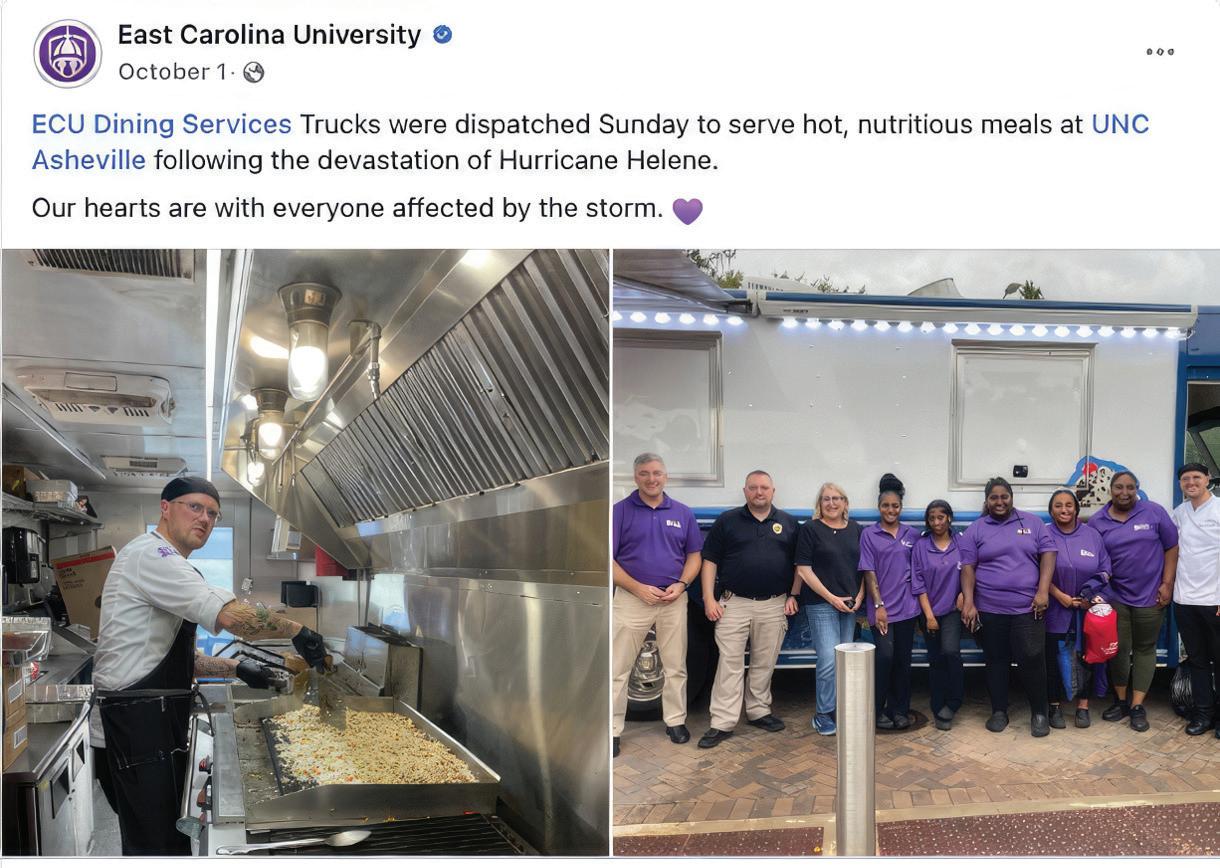

WINTER 2025 VOLUME 23, NUMBER 1 East is produced by East Carolina University
Managing Editor
Doug Boyd ’99
Art Director
Mike Litwin ’01
Photographers
Rhett Butler, Steven Mantilla
Contributing Writers
Benjamin Abel, Crystal Baity, Ken Buday ’89, Steven Grandy, Lacey Gray, Jeannine Manning Hutson, Michael Rudd, Kim Tilghman, Patricia Earnhardt Tyndall, Ronnie Woodward ‘08
Contributing Photographers
Jo Anne Balanay, Aaron Hines, Eric Morgensen, WITN
Copy Editor
Jimmy Rostar ’94
Chief Communications Officer
Jeannine Manning Hutson
Contact Us
• 252-737-1973
• easteditor@ecu.edu • www.ecu.edu/east
Customer Service
To start or stop a subscription or to let us know about a change of address, please contact Advancement Services at advancementservices@ecu.edu or 252-328-GIVE (4483).
Send letters to the editor to:
easteditor@ecu.edu or Howard House
Mail Stop 107
East Carolina University Greenville, N.C. 27858-4353
32,850 copies of this public document were printed at a cost of $32,850.00 or $1.00 per copy.
Howard House Mail Stop 107 East Carolina University Greenville, NC 27858-4353


11.10.24